Super soft and velvety lemon cake with homemade lemon curd, lemon ganache drip, and a truly delicious lemon cream cheese frosting! This lemon cake literally melts in your mouth it is so soft and tender. You won't ever need another lemon cake recipe after trying this one!
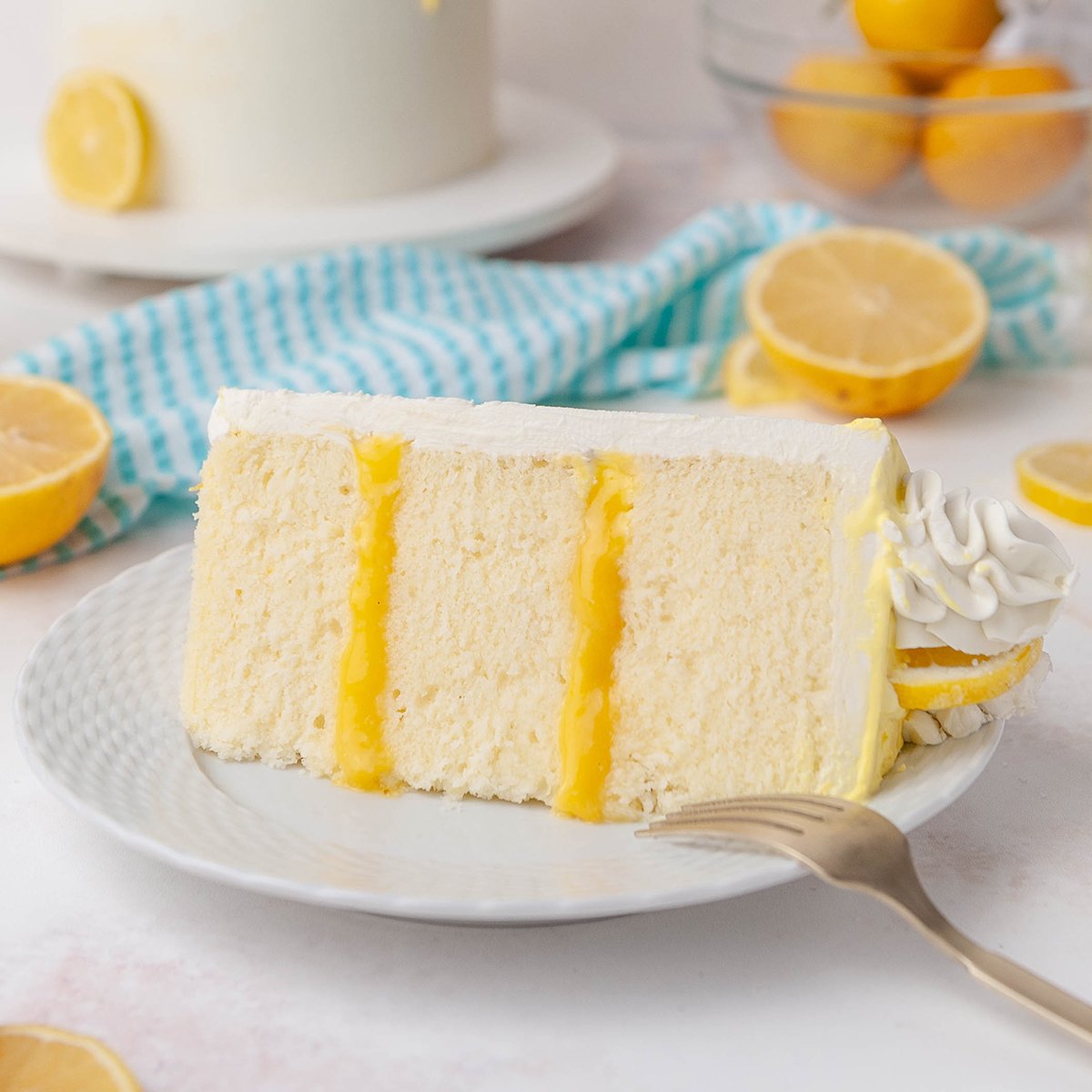
This lemon cake is a reader favorite and always gets rave reviews! If you're not familiar with making a layer cake, then you should check out my video on how to make your first cake to get the basics and terminology down.
When I make this cake, I make my curd one day in advance so that it has time to cool down in the fridge. You can also bake your cakes in advance if you want, and then wrap them in plastic wrap and freeze them until you are ready to decorate.
What's in this blog post?
Lemon cake ingredients
This lemon cake has tons of natural lemon flavor thanks to lemon juice, lemon zest, and some pure lemon extract. If you plan on making the lemon curd (which you TOTALLY should,) make sure you have at least 8 large lemons for the cake and curd combined or you can buy lemon juice to use in the curd if you don't want to juice a bunch of lemons.
We will also be making a lemon ganache drip but instead of cream, we are using lemon juice! Did you know you can make ganache with lemon juice? Mind blown!
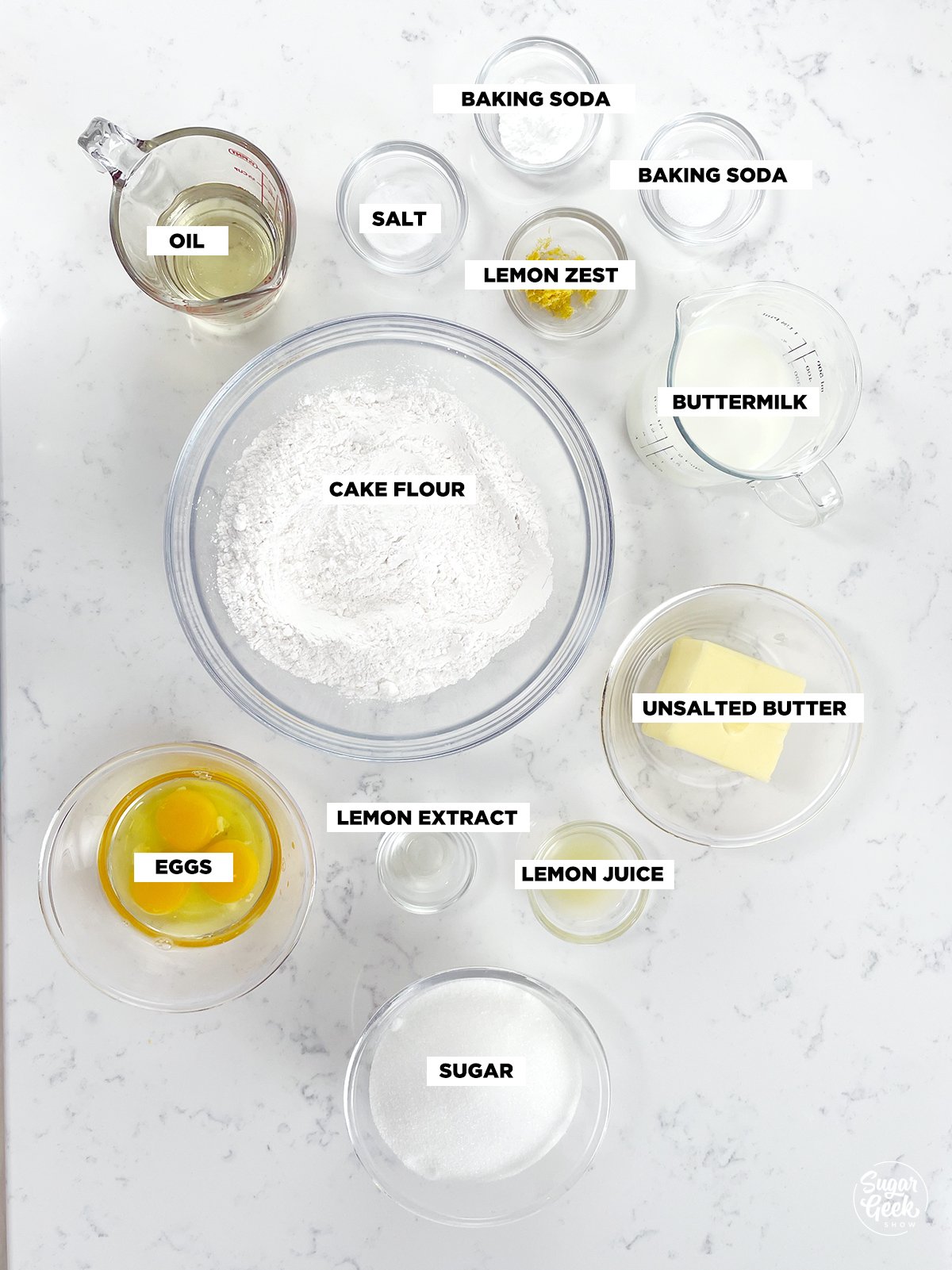
You will also need cream cheese and unsalted butter for the frosting. See the full list of ingredients in the recipe card at the bottom of this post.
What makes this lemon cake so moist?
This lemon cake recipe, much like my vanilla cake and white velvet buttermilk cake recipes, has some key ingredients for maximum moistness and melt-in-your-mouth velvet texture.
- Buttermilk - breaks down the gluten in cake flour and reacts with acidic ingredients to create a very light and fluffy cake that is extremely tender! No buttermilk? No problem, you can make your own buttermilk substitute.
- Cake flour - cake flour has less gluten in it than AP flour, resulting in a very tender cake crumb. **Note, you can't do that trick where you replace AP flour with cornstarch or you'll end up with cornbread. If you live in the UK, try searching for Shipton Mills soft cake and pastry flour, or any flour that has a protein content of 9% or less.
- Reverse mixing method - The reverse creaming method is the process of coating your dry ingredients with butter before you add the liquids. This butter "shortens" the gluten strands and gives the cake its velvet crumb.
- Oil - Very important in butter cakes to keep your cakes from drying out. When a cake is cold, the butter in the cake get's hard and can make the cake taste dry. Cakes should always be consumed at room temperature for the best results.
Lemon curd step by step
Once you make your own lemon curd, it's hard to ever go back to buying it. Nothing compares to that pure, bright, fresh lemon flavor. I prefer to make my lemon curd one day in advance and then have it ready to go the next day.
- Zest your lemons then slice then juice them. Make sure you strain out any seeds or lemon bits.
- Place the egg yolks, cornstarch, and salt in a medium-sized heatproof bowl and whisk together until smooth.
- Add your lemon juice, sugar, and lemon zest to a saucepan and bring to a simmer while whisking occasionally.
- When your lemon mixture reaches a simmer, scoop out one cup of the hot liquid (carefully) and pour it into the egg mixture while whisking at the same time so you don't curdle your eggs.
- Now add the tempered egg mixture back into the lemon mixture in a slow stream while whisking constantly to prevent over-heating the eggs.
- Continue cooking over medium heat while mixing constantly until it thickens or reaches 170 - 180ºF on a thermometer.
- Remove the lemon curd from the heat and add your butter. Whisk until smooth.
- Pour the finished lemon curd into a heatproof container and cover it with plastic wrap (make sure the wrap is touching the surface of the curd) and refrigerate. Let it cool down completely before you use it.
Lemon cake step by step
- Bring all your ingredients to room temperature or even a little warm (eggs, buttermilk, butter, etc) to ensure your batter does not break or curdle.
- Use a scale to weigh your ingredients (including liquids) unless otherwise instructed (Tablespoons, teaspoons, pinch etc). Metric measurements are available in the recipe card. Scaled ingredients are much more accurate than using cups and help ensure the success of your recipe.
- Preheat your oven to 335º F/168º C Prepare your cake pans with cake goop or another pan release. For square pans or cakes over 12", I also use parchment paper.
- Combine the 4oz of buttermilk with the oil and set aside.
- To the remaining 6oz of buttermilk, add your eggs, lemon zest, lemon extract, and lemon juice. Whisk lightly to break up the eggs and set it aside.
- Place the cake flour, sugar, salt, baking powder, and baking soda into the bowl of your stand mixer with the paddle attachment attached.
- Turn the mixer onto the lowest speed. Add in your softened butter in small chunks and mix on medium until the flour mixture resembles coarse sand. About 1 minute.
- Add your oil/milk mixture all at once to the dry ingredients and mix on medium (speed 2 on a bosch, speed 4 on your KitchenAid) for two full minutes to develop the cake's structure.
- Slowly add in the milk/egg mixture in 3 parts, letting the batter mix for 10 seconds between additions. Stop to scrape the bowl once more halfway through. Your batter should be thick and not separated. If it is separated, some of your ingredients could have been too cold or you added your liquids too quickly.
- Fill your cake pans ¾ full with cake batter. You can also weigh your cake pans to ensure that each pan has the same amount of cake batter.
- Bake your cakes for 30-40 minutes or until a toothpick comes out from the center cleanly.
- After removing your cakes from the oven, I give them a quick tap on the countertop to release air and prevent shrinking.
- After cakes have cooled for 10 minutes or the pans are cool enough to touch, flip the cakes over onto a cooling rack and let cool until barely warm. Wrap your cakes in plastic wrap and chill in the refrigerator before frosting so they are easier to handle. You can also put them in the freezer if you are in a hurry for them to cool down.
- Once the cakes are chilled you can now trim, fill and decorate your cake as you wish.
Cream cheese frosting
- Make sure your butter and your cream cheese are both softened but not melted. Cold butter or cold cream cheese will not cream together properly and you'll get lumps in your frosting. You can soften by cutting into chunks and leaving at room temperature or you can microwave for 15 seconds until softened.
- Place your butter into your stand mixer with the whisk attachment and cream until smooth (you can also do this by hand or with a hand mixer).
- Add your cream cheese and cream on low until smooth and combined.
- While mixing on low, start adding in your powdered sugar one cup at a time until its all in and everything is smooth.
- Then add in your extract and salt. Cream until just combined and you're done!
Lemon cake assembly
Now that we've got our curd, cream cheese frosting and lemon cake baked, it's time to assemble! If you need more basic instructions on how to make your first cake, you can watch my beginners cake tutorial.
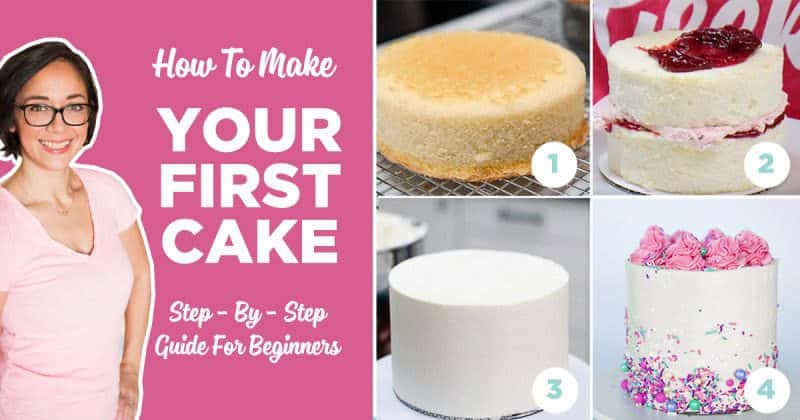
- Trim the domes off the tops of your cakes to level them and trim off the brown edges if you wish.
- Place your first layer of cake onto a cake board or cake platter. Add a dam of buttercream around the outside edge of the cake and fill the center with about ¼" of lemon curd.
- Place your second layer on top and repeat the process and add the third layer on top.
- Apply a thin coat of buttercream to the whole cake (crumbcoat) and place into the fridge for 15 minutes.
- Apply the final layer of buttercream and smooth it out with a bench scraper and offset spatula.
- Place the cake in the fridge to continue chilling while you make the lemon water ganache.
- Microwave your chocolate and lemon juice in 30 second increments (or place on a double boiler) until melted. Add a drop of yellow food coloring and white food coloring and whisk until smooth. Let the ganache cool to 90ºF before you use it or it might run down the sides of the cake too much.
- Pipe the lemon ganache on top of the cake using a piping bag. Smooth out the top with an offset spatula.
- After the ganache sets (about 10 minutes) add some more swirls of buttercream on top of the cake using an open start tip and some lemon slices.
This lemon cake is literally bursting at the seams with so much lemon flavor! I love this cake so much! The cake is so so soft and fluffy but combined with the lemon curd and the lemon ganache, this cake is far and above the best lemon cake ever.
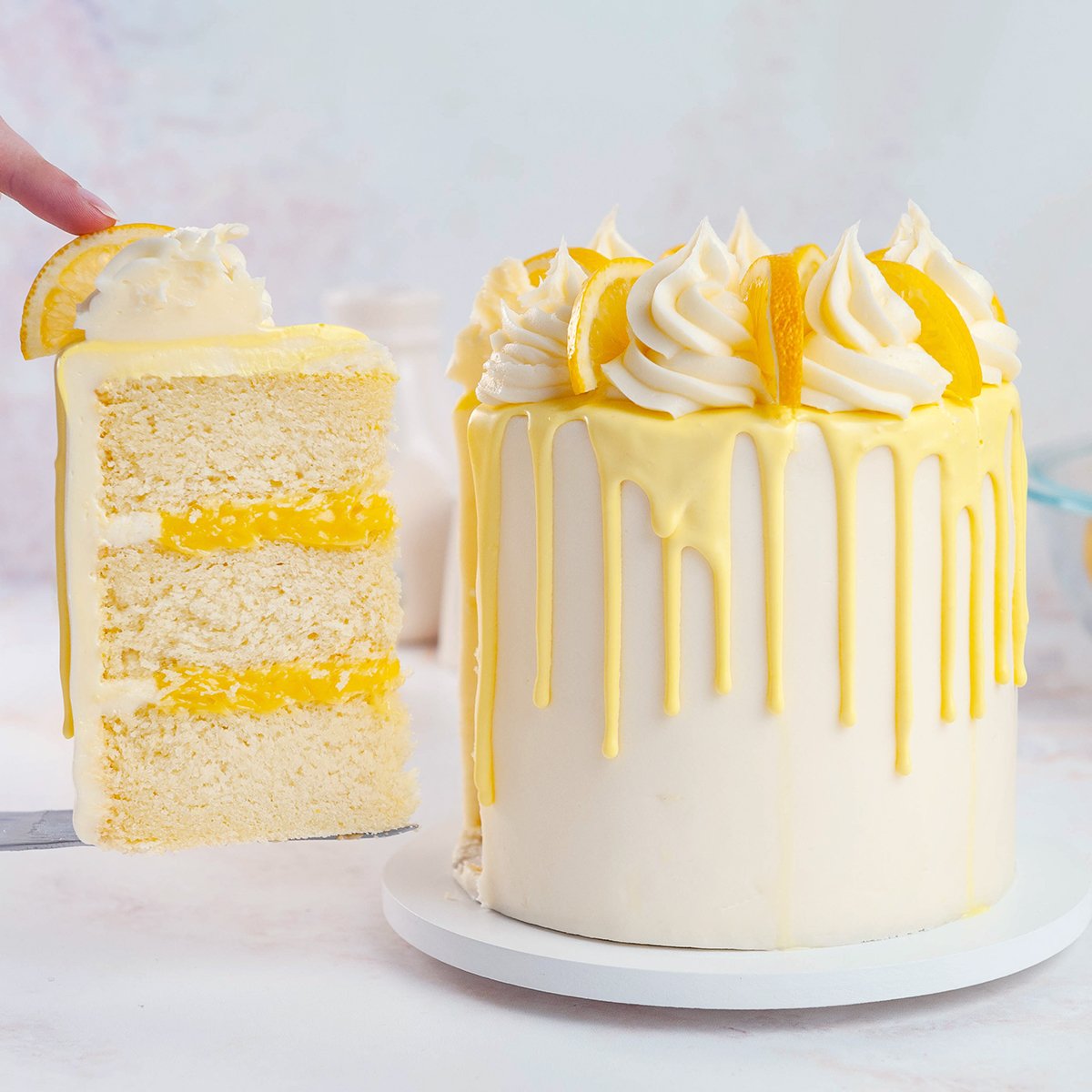
Lemon Cake FAQ
Lemon juice actually does not have a lot of lemon flavor and adds a lot of water to the recipe. If you don't have lemon extract, it's better to use more lemon zest to add lemon flavor.
You can turn most cake recipes into cupcakes but leave out the oil since it makes the cupcakes too greasy. Not all cake translates into cupcakes well. These are the steps I use to test a cake recipe out for cupcakes.
Preheat your oven to 400ºF.
Fill your liner ⅔ of the way full (about 3 Tablespoons of cake batter). Over-filling your liners can cause them to overflow and collapse.
Bake cupcakes for 5 minutes then reduce the temperature to 350ºF. This helps set the dome.
Continue baking the cupcakes for an additional 12 minutes and check the centers. If they are still soft and not set, continue baking. Most cupcakes are done between 18-25 minutes.
Once your cupcakes are done baking, remove the pan from the oven and let them cool on a wire rack for 10 minutes before taking them out of the cupcake pan.
Inspect your results. If the cupcake didn't rise enough, put more batter in next time. If it over-flowed, put in less. Take note of how long it took for the cupcakes to bake.
Use grease-proof liners to help combat the liners becoming transparent after baking.
Yes you sure can! If you want to make this lemon cake into a lime cake, just replace the zest and juice with lime. I haven't been able to find lime extract so I just used lemon. Call it a lemon lime cake.
Other Lemon Recipes You'll Love
Moist and fluffy lemon raspberry cake
Cake Batter and Frosting Calculator
Select an option below to calculate how much batter or frosting you need. Adjust the servings slider on the recipe card to change the amounts the recipe makes.
Choose a pan type
Choose a cake pan size
(based on 2" tall cake pan)
Choose a cake pan size
(based on 2" tall cake pan)
Cupcake Tin Size
Choose number of pans
Cups of Batter Needed
8 cups
Cups of Frosting Needed
5 cups
Note: measurements are estimated based off the vanilla cake recipe using standard US cake pans and sizes. Measurements used are for 2" tall cake pans only. Your results may vary. Do not overfill cake pans above manufacturer's recommended guidelines.
Recipe

Equipment
- Stand Mixer
Ingredients
Lemon Cake Ingredients
- 13 ounces Cake flour
- 13 ounces granulated sugar
- ½ teaspoon salt
- 2 teaspoon baking powder
- ½ teaspoon baking soda
- 8 ounces unsalted butter Softened but not melted
- 10 ounces buttermilk Or regular milk with 1 tablespoon white vinegar added
- 3 ounces vegetable oil Or canola oil
- 3 Large Eggs 1 large egg weighs about 1.67oz
- 1 Tablespoon Lemon Zest About one lemon
- 2 teaspoons Lemon Extract
- 2 Tablespoons Lemon Juice Fresh or bottled is ok
Lemon Curd
- 8 ounces Lemon Juice Fresh or bottled is ok
- 1 Tablespoon Lemon Zest About one lemon
- 6 ounces Granulated Sugar
- 5 large Egg Yolks
- ¼ teaspoon salt
- 4 ounces Unsalted Butter
- 1 Tablespoon cornstarch
Lemon Cream Cheese Frosting
- 16 ounces cream cheese softened
- 8 ounces Unsalted Butter Softened but not melted
- 36 ounces Powdered Sugar sifted
- ½ teaspoon lemon extract
- ½ teaspoon salt
Lemon Juice Ganache
- 1 ounce lemon juice + 1 Tablespoon
- 6 ounces white chocolate I use Ghirardelli candy melts
- 1 drop white food coloring optional
- 2 drops yellow food coloring optional, I use Americolor lemon yellow gel color
Instructions
Lemon Cake Instructions
- Preheat your oven to 335º F/168º C Prepare three, 6"x2" or two, 8"x2" cake pans with cake goop or another pan release. For square pans or cakes over 12", I also use parchment paper.
- Combine the 4oz of buttermilk with the oil and set aside.
- To the remaining 6oz of buttermilk, add your eggs, lemon zest, lemon extract, and lemon juice. Whisk lightly to break up the eggs and set aside.
- Place cake flour, sugar, salt, baking powder, and baking soda into the bowl of your stand mixer with the paddle attachment attached.
- Turn the mixer onto the lowest speed. Add in your softened butter in small chunks mix until the flour mixture resembles coarse sand.
- Add your oil/milk mixture all at once to the dry ingredients and mix on medium (speed 2 on a bosch, speed 4 on KitchenAid) for 2 full minutes to develop the cake's structure.
- Scrape the bowl. This is an important step. If you skip it, you will have hard lumps of flour and unmixed ingredients in your batter. If you do it later, they will not mix in fully.
- Slowly add in the milk/egg mixture in 3 parts, letting the batter mix for 10 seconds between additions. Stop to scrape the bowl once more halfway through. Your batter should be thick and not separated. If it is separated, some of your ingredients could have been too cold or you added your liquids too quickly.
- Fill your cake pans ¾ full with cake batter. Give the pan a little tap on each side to level out the batter and get rid of any air bubbles. You can also weigh your cake pans to ensure that each pan has the same amount of cake batter.
- Bake at 335º F/168º C for 35-40 minutes or until a toothpick comes out cleanly from the center of the cake and the top of the cake bounces back when you touch it.
- After cakes have cooled for 15 minutes or the pans are cool enough to touch, flip the cakes over onto a cooling rack and let cool until barely warm. Wrap your cakes in plastic wrap and chill in the refrigerator before frosting so they are easier to handle. You can also put them in the freezer if you are in a hurry for them to cool down.
- Once the cakes are chilled you can now trim, fill, and decorate your cake as you wish.
Lemon Curd Instructions
- Zest the lemons, then slice them in half and juice them into a measuring cup. Use a small colander or a lemon juicer to keep out any seeds.
- Place the egg yolks, cornstarch, and salt in a large bowl. Whisk well to combine and set aside. (You will be adding more to this later, so make sure it's a large enough bowl.)
- Add your lemon juice, granulated sugar, and lemon zest to a large, shallow sauté pan.
- Stir constantly with a whisk and bring to a simmer over medium heat.
- When it has reached a simmer, scoop about 1 cup of the lemon juice mixture and slowly add it into the egg yolk mixture while whisking.
- Add the tempered egg mixture back into the lemon mixture while whisking constantly. Keep an eye on it and keep whisking, if you walk away for even a minute, the eggs can curdle.
- Whisk constantly and cook over medium heat until desired thickness. I cook mine for about 2 minutes because I like thick lemon curd. Use a thermometer to check the temperature of the lemon curd. Removing the curd at 170ºF (76ºC)will yield a thinner consistency while removing at 180ºF (82ºC) will be thicker.
- Add your butter in chunks to the lemon curd and whisk until the buter is melted and combined. Remove the lemon curd from the heat. It will continue to thicken as it cools.
- Pour the finished lemon curd into a heat-proof jar or bowl. Cover the curd with plastic wrap so that it is touching the surface of the curd without any air bubbles in between, this will prevent a skin from forming on the top of the curd. Store it in the fridge for up to one week or freeze it for up to a year.
Lemon Cream Cheese Frosting
- Place softened butter in the bowl of your stand mixer with whisk attachment and cream on low until smooth. Or you can use a hand mixer!
- Place softened cream cheese in the bowl with butter in small chunks and blend on low until smooth and combined
- Add in sifted powdered sugar one cup at a time until combined
- Add your lemon extract and salt and mix until just combined. Do not over-mix or your frosting will separate and get watery.
Lemon Ganache
- Microwave your chocolate for 1 minute and lemon juice for 30-seconds. (Or place on a double boiler.) Pour the lemon juice over the chocolate and let sit for 5 minutes. Whisk until smooth.
- Add a drop of yellow food coloring and white food coloring and whisk until smooth. Let the ganache cool to 90ºF before you use it or it might run down the sides of the cake too much. Make sure your cake is chilled as well before dripping.
Video
Notes
- Weigh your ingredients to avoid cake failure. Using a kitchen scale for baking is super easy and gives you the best results every single time.
- Make sure all your cold ingredients are room temperature or slightly warm (butter, milk, eggs, to create a cohesive batter. Curdled batter causes cakes to collapse.
- No buttermilk? You can make your own buttermilk
- Do not fall for the “just add cornstarch to regular flour” trick. It does not work for this recipe. Your cake will look and taste like cornbread. If you can’t find cake flour, use pastry flour which isn’t quite as soft as cake flour but it’s better than all-purpose flour.
- If you’re in the UK search for Shipton mills cake and pastry flour. If you’re in another part of the country, search for low protein (about 9%) cake flour.
- Need more help with making your first cake? Check out my how to decorate your first cake blog post.
- Make your own pan release (cake goop!) The best pan release ever!
- Chill your cakes before frosting and filling. You can cover a frosted and chilled cake in fondant if you wish. This cake is also great for stacking. I always keep my cakes chilled in the refrigerator before delivery for easy transporting.
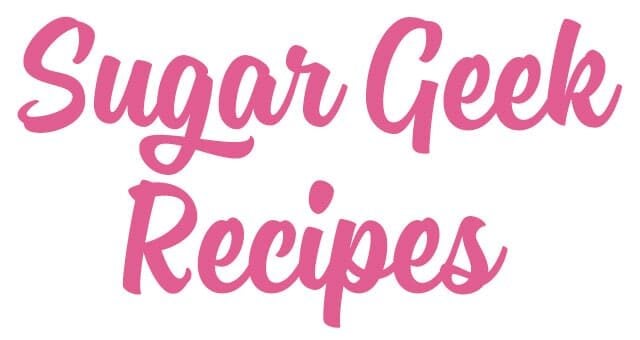

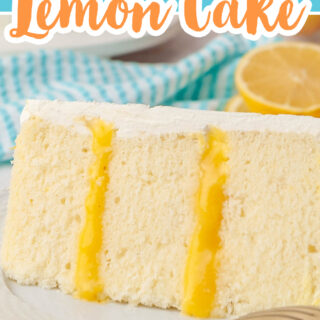
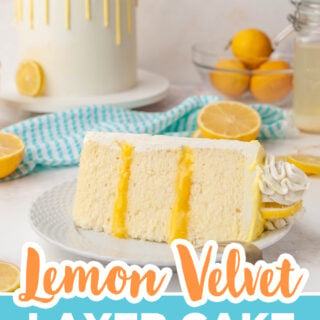
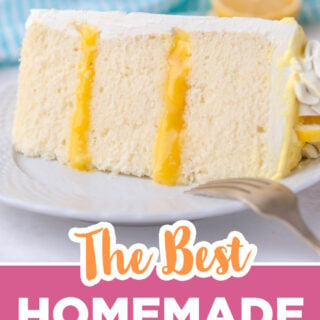
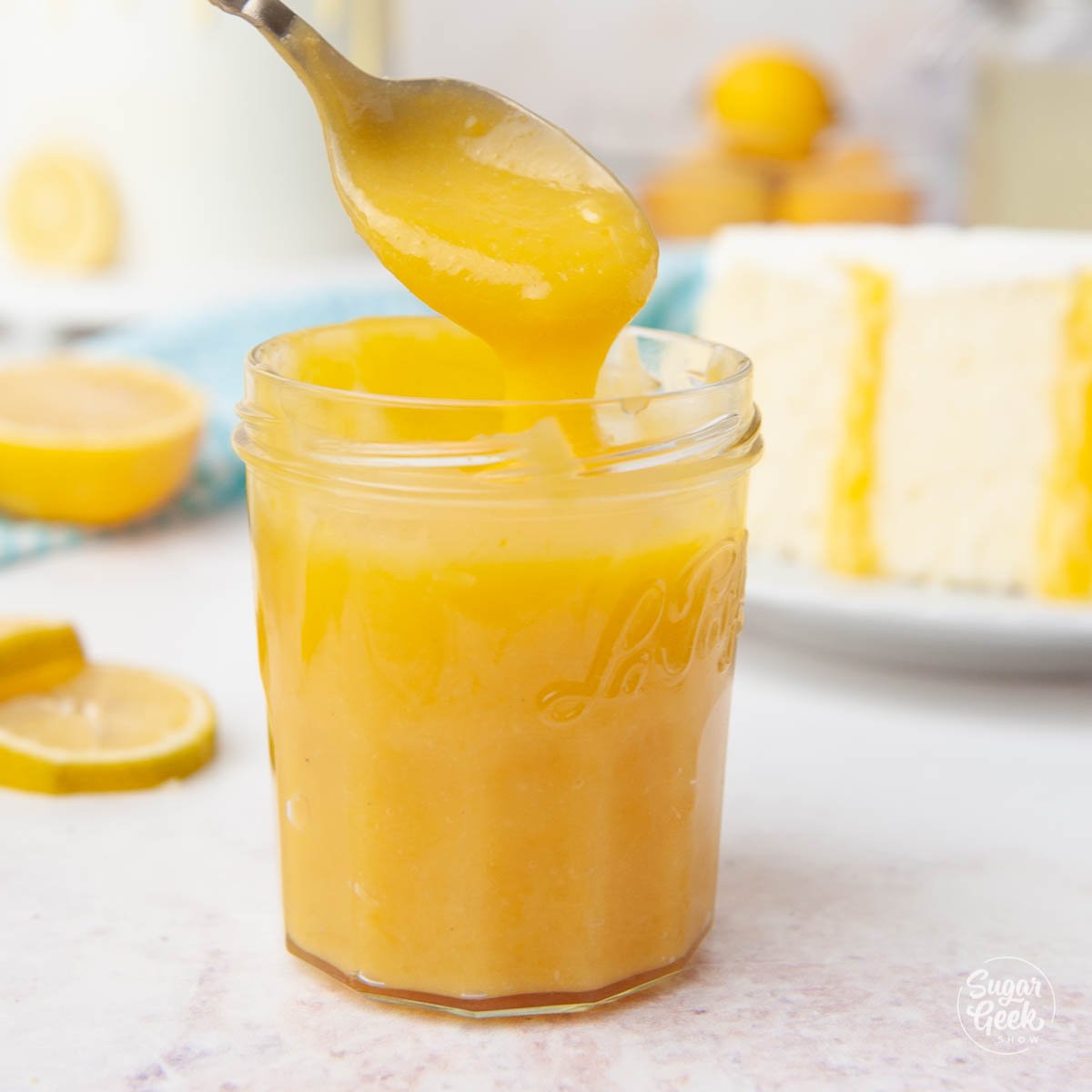
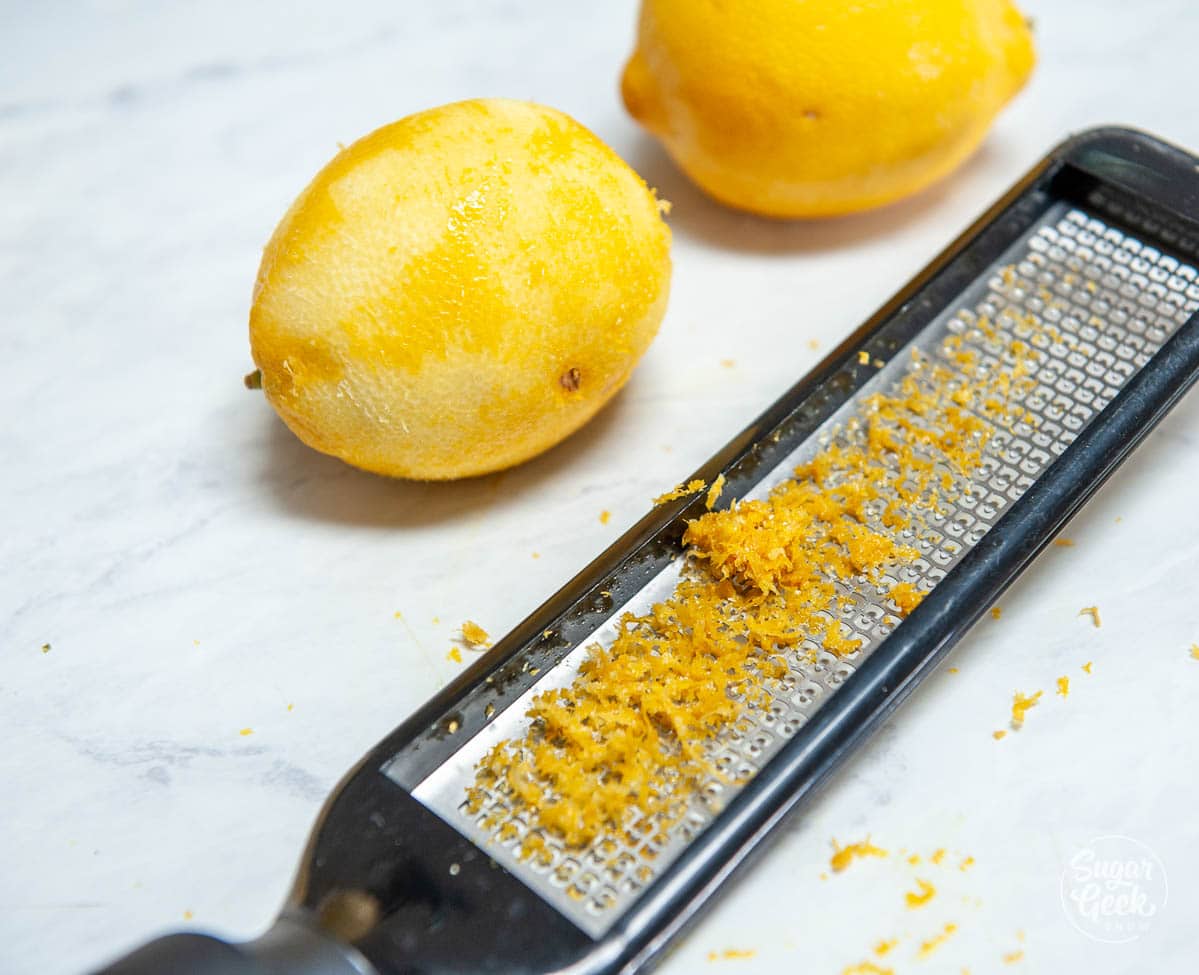
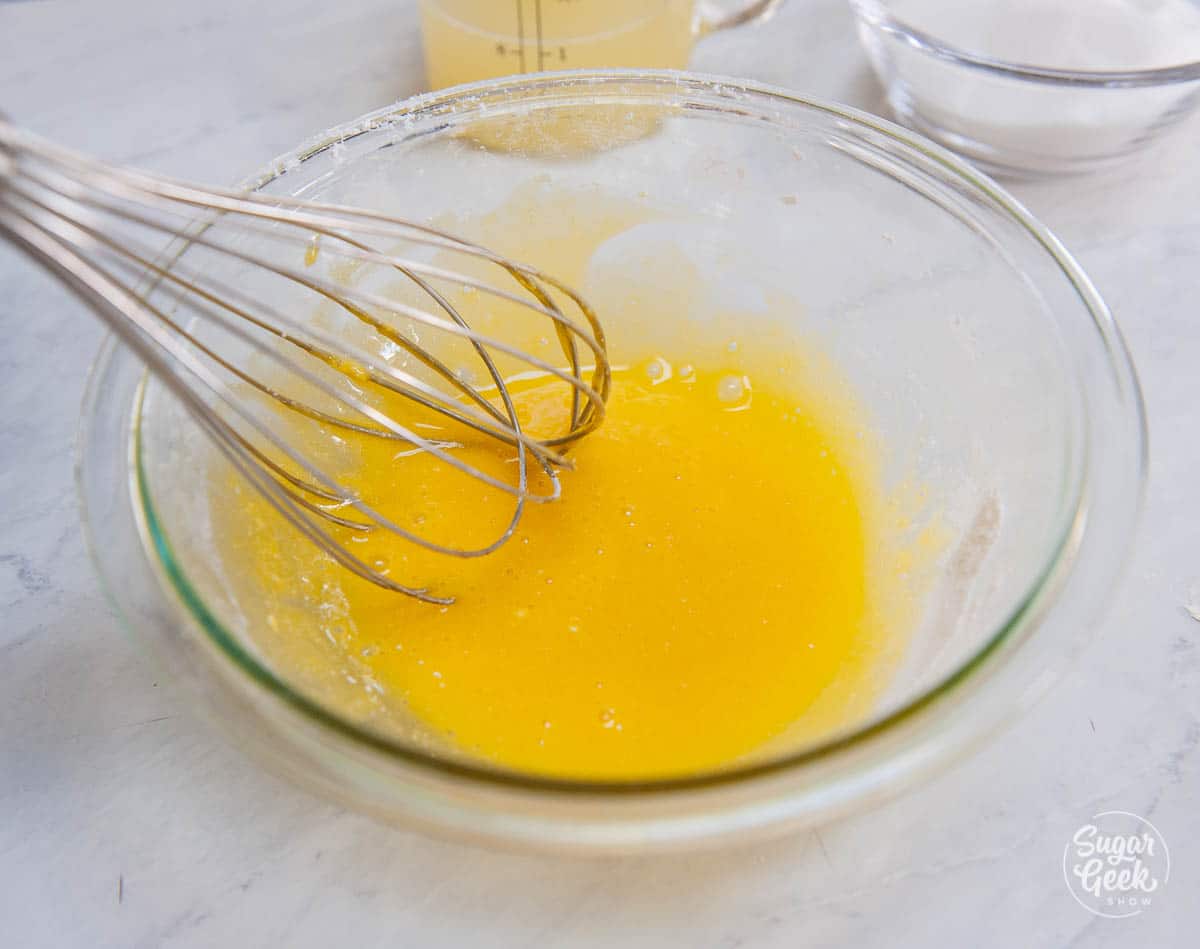
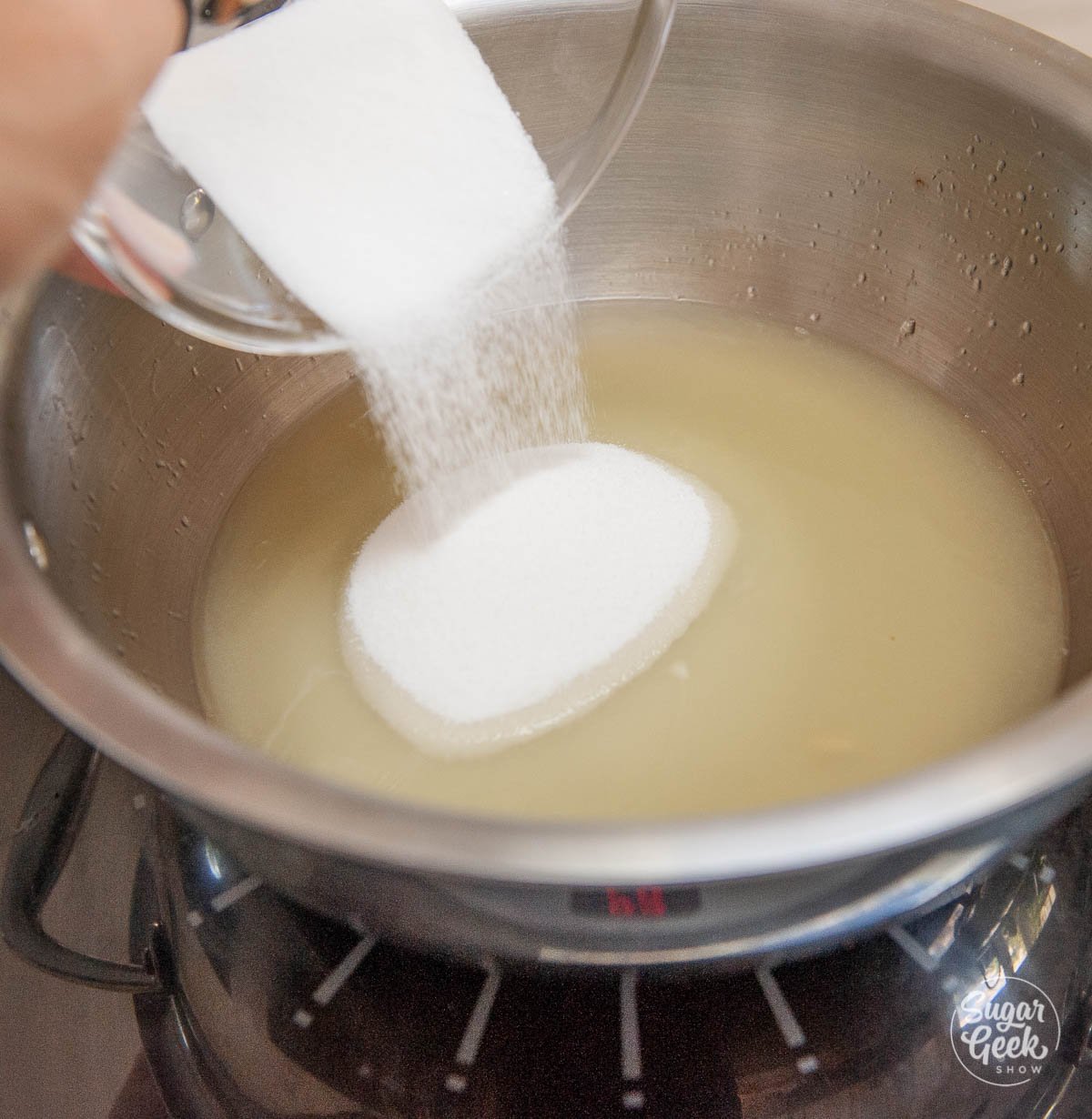

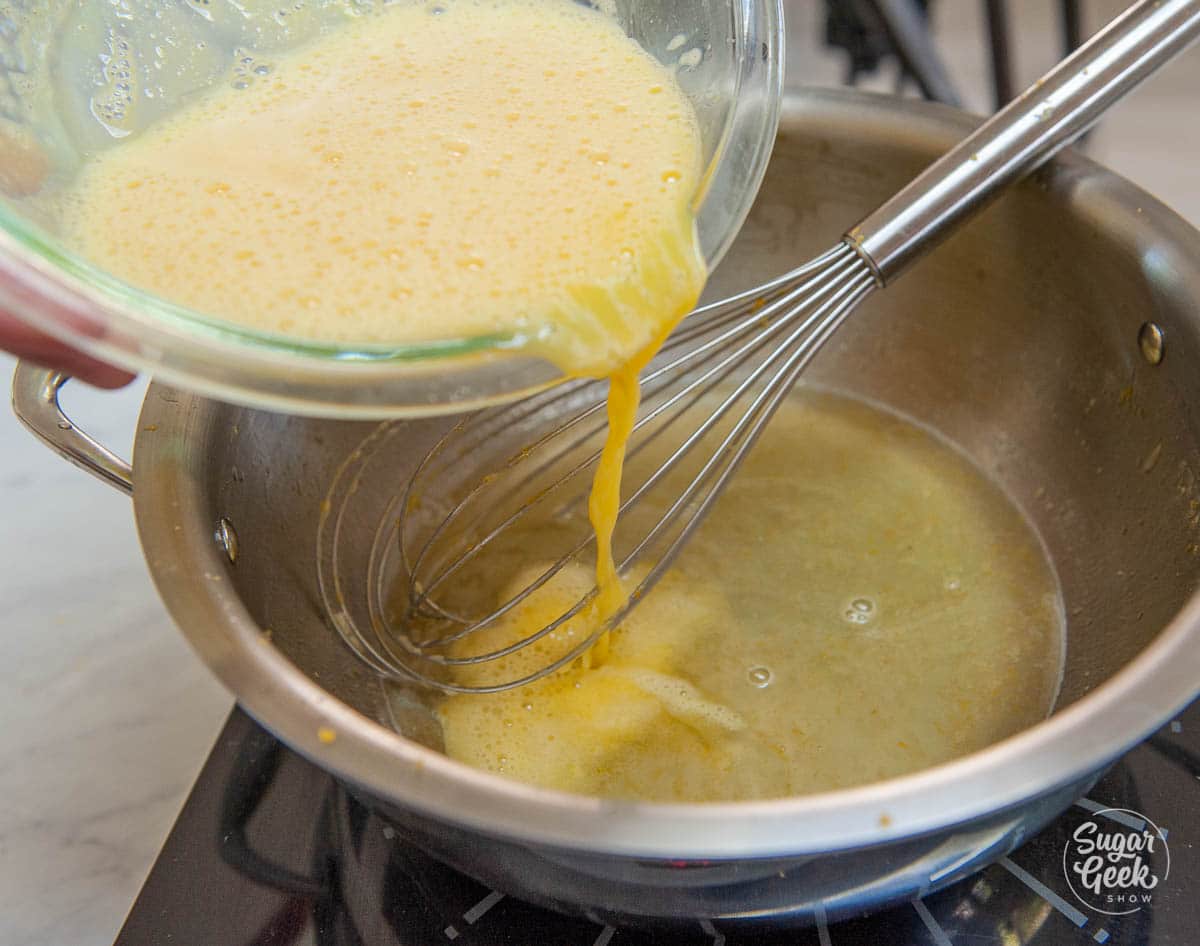
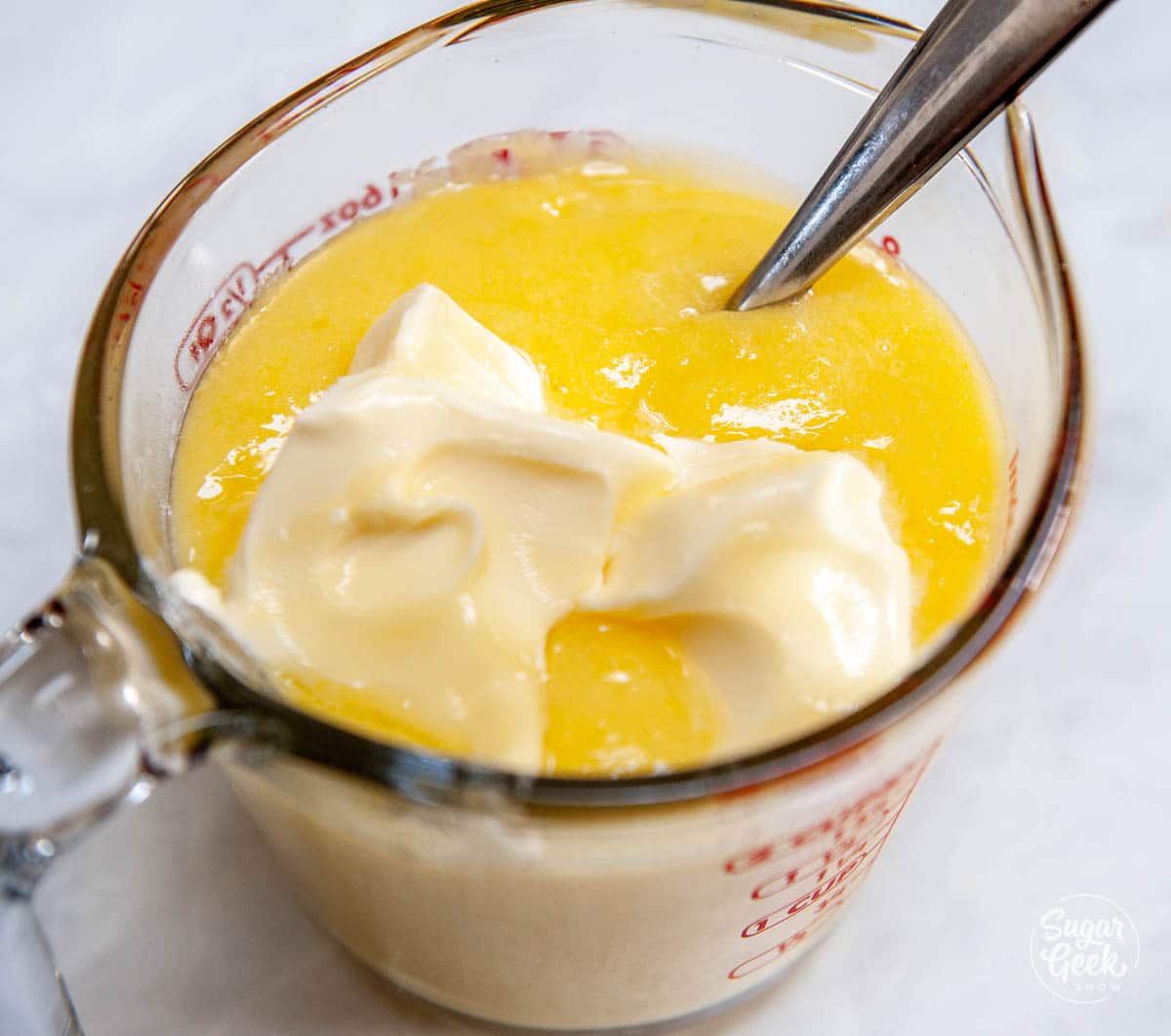
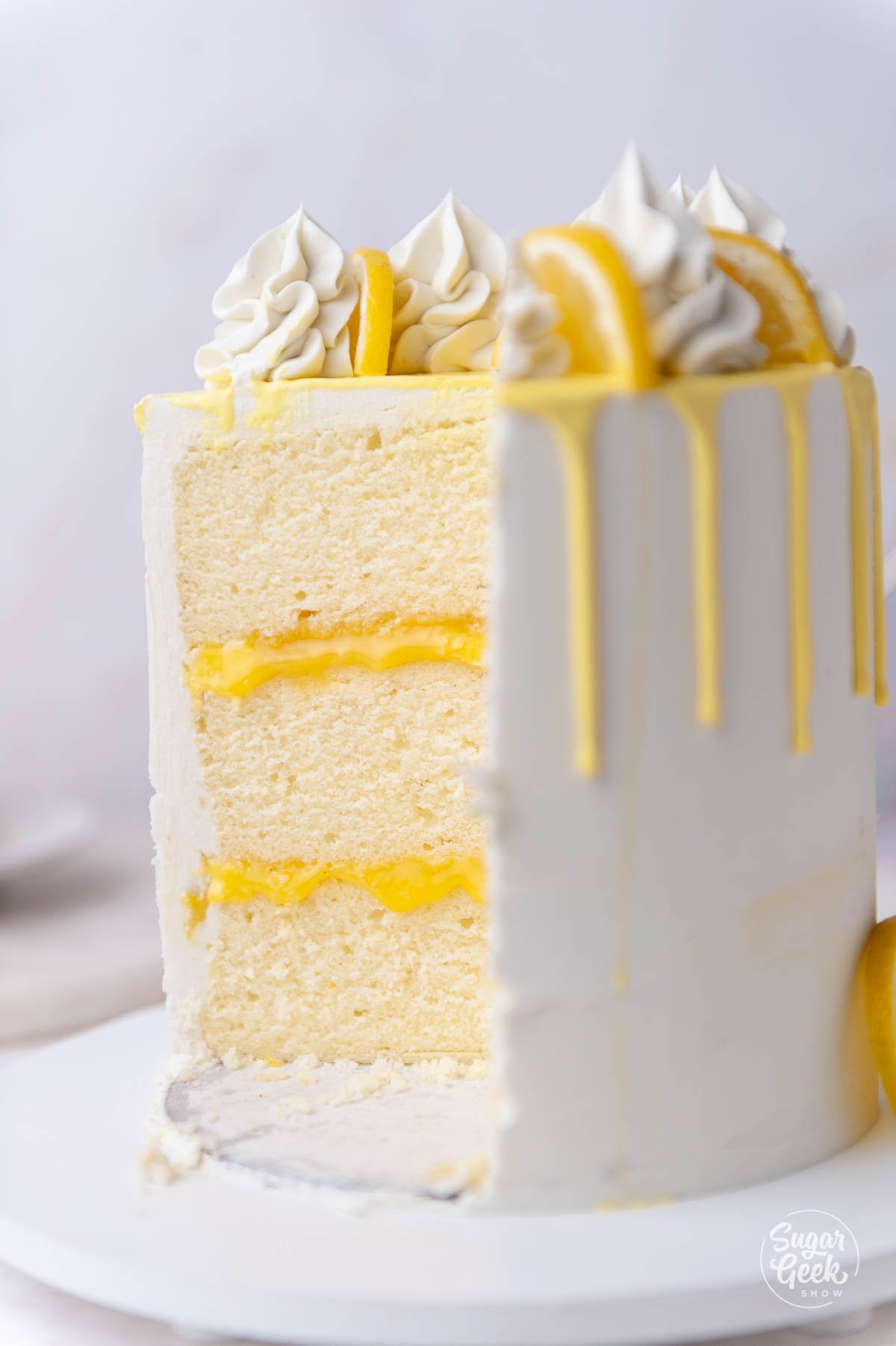
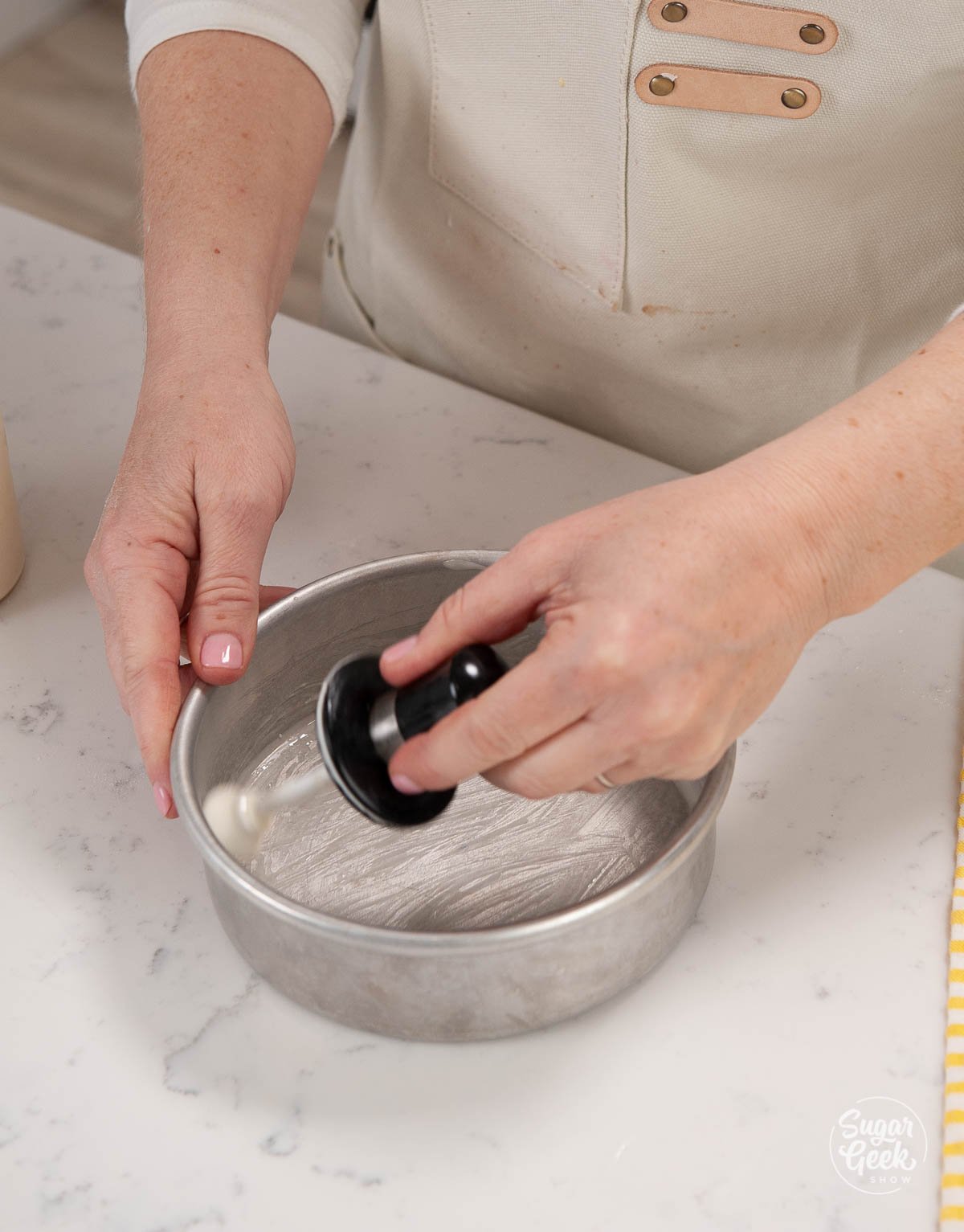
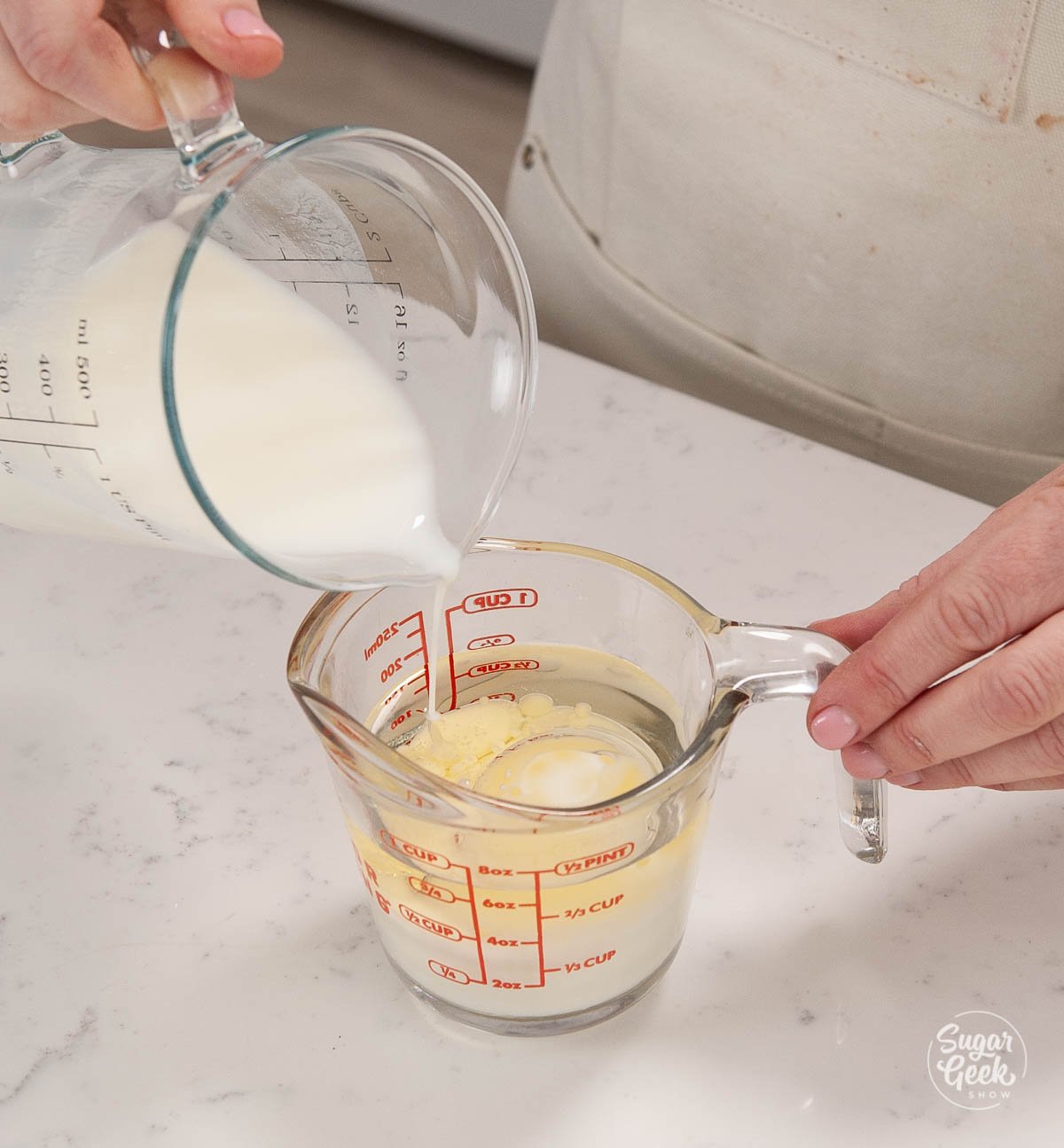
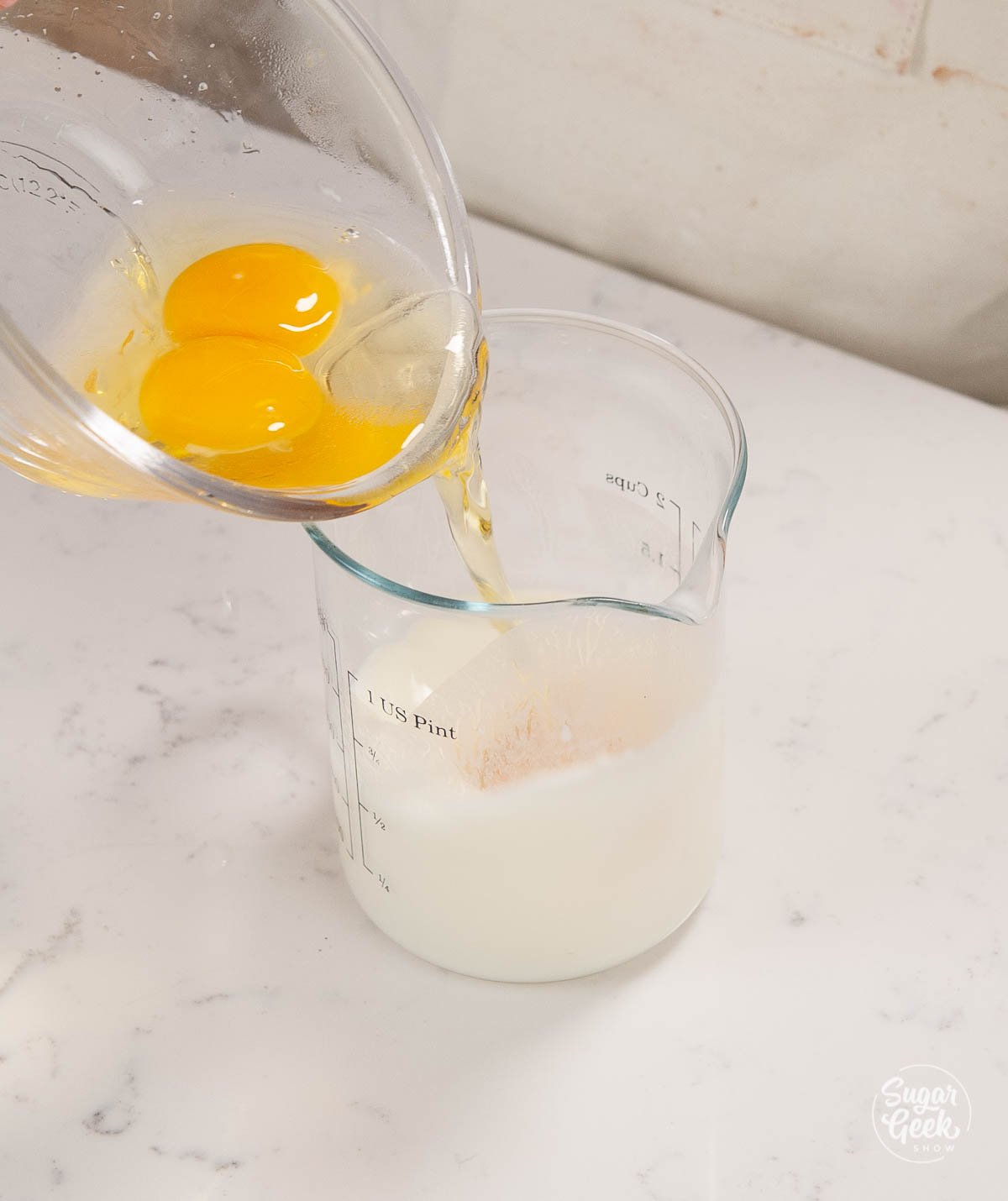
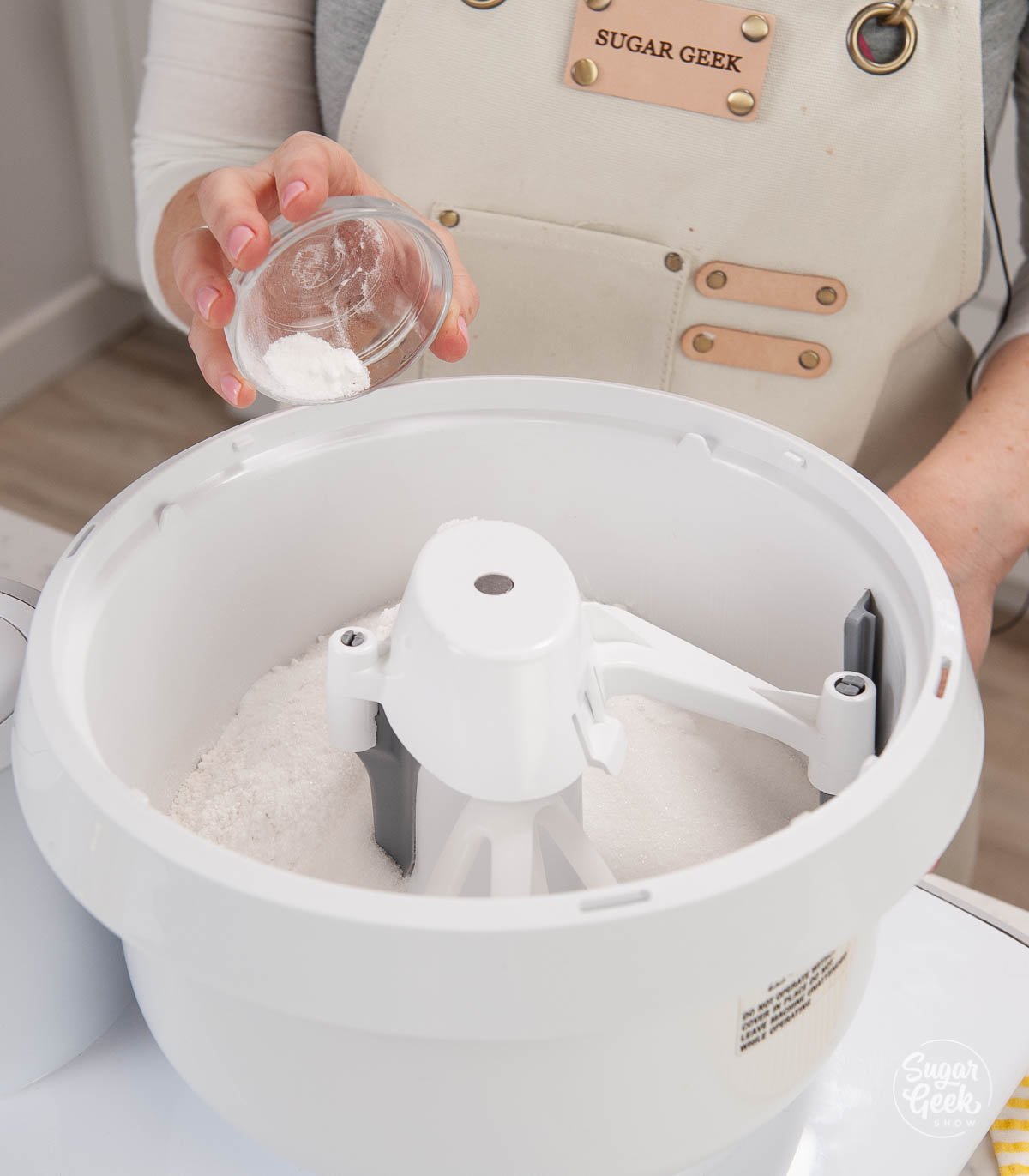
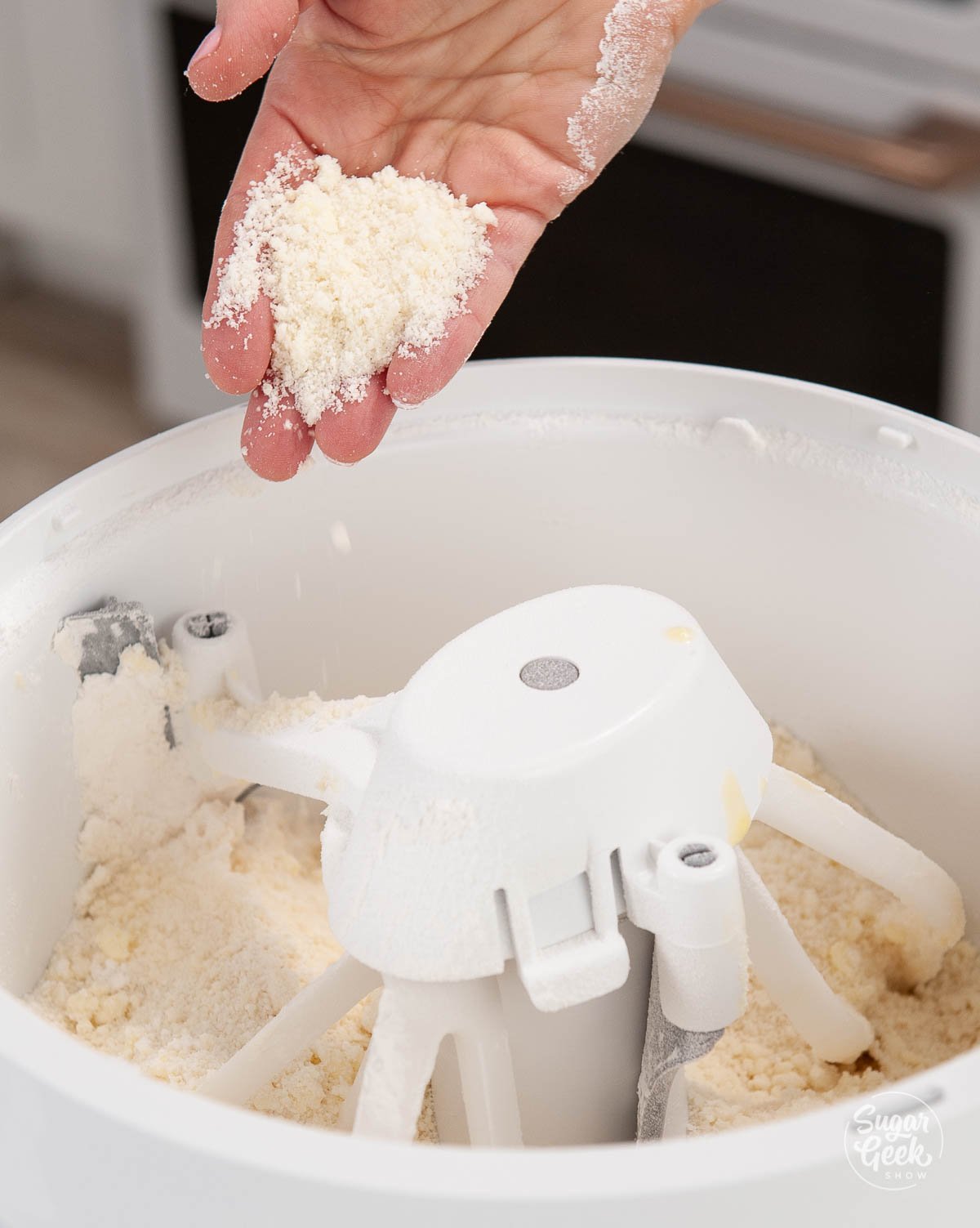
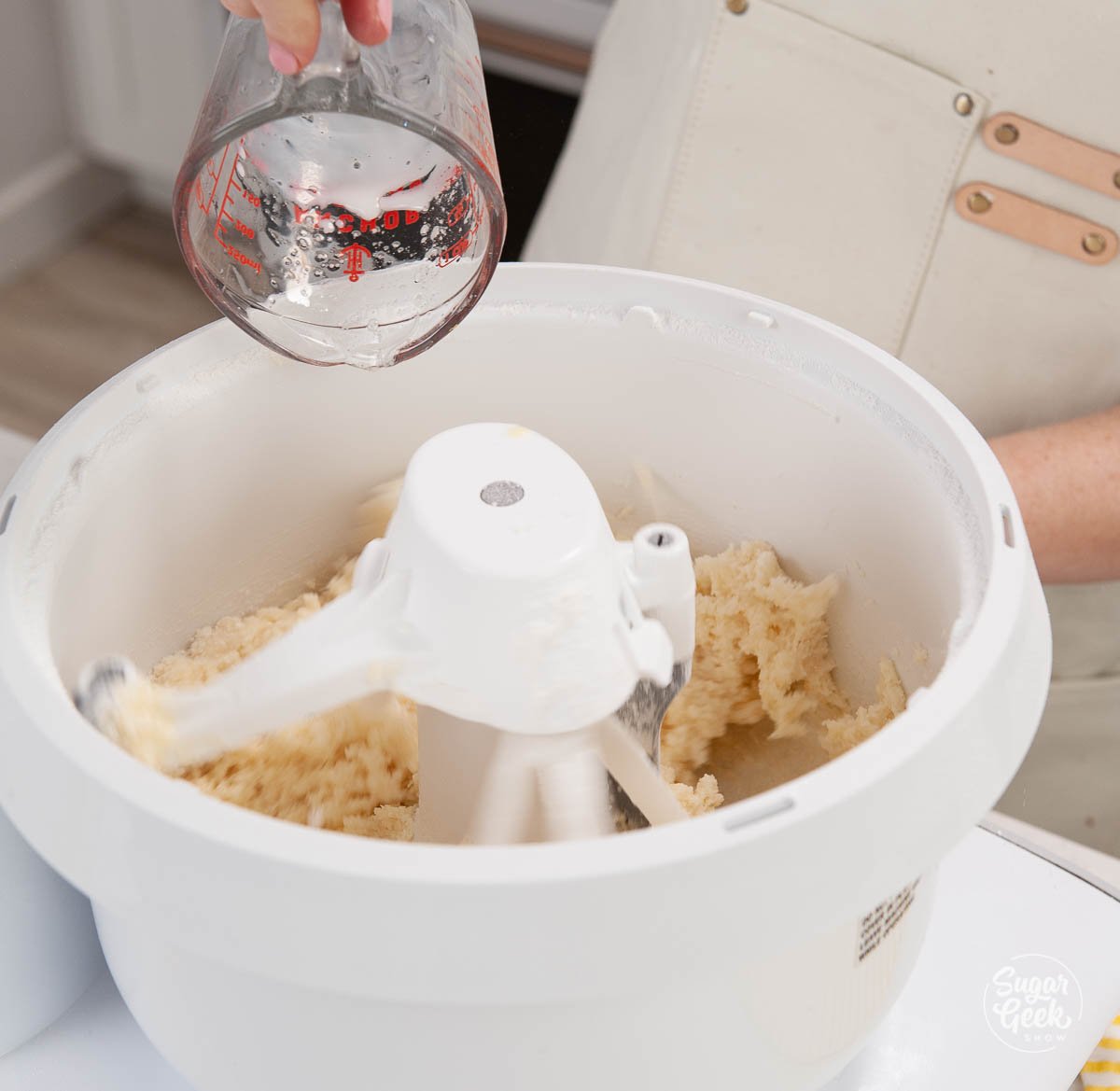
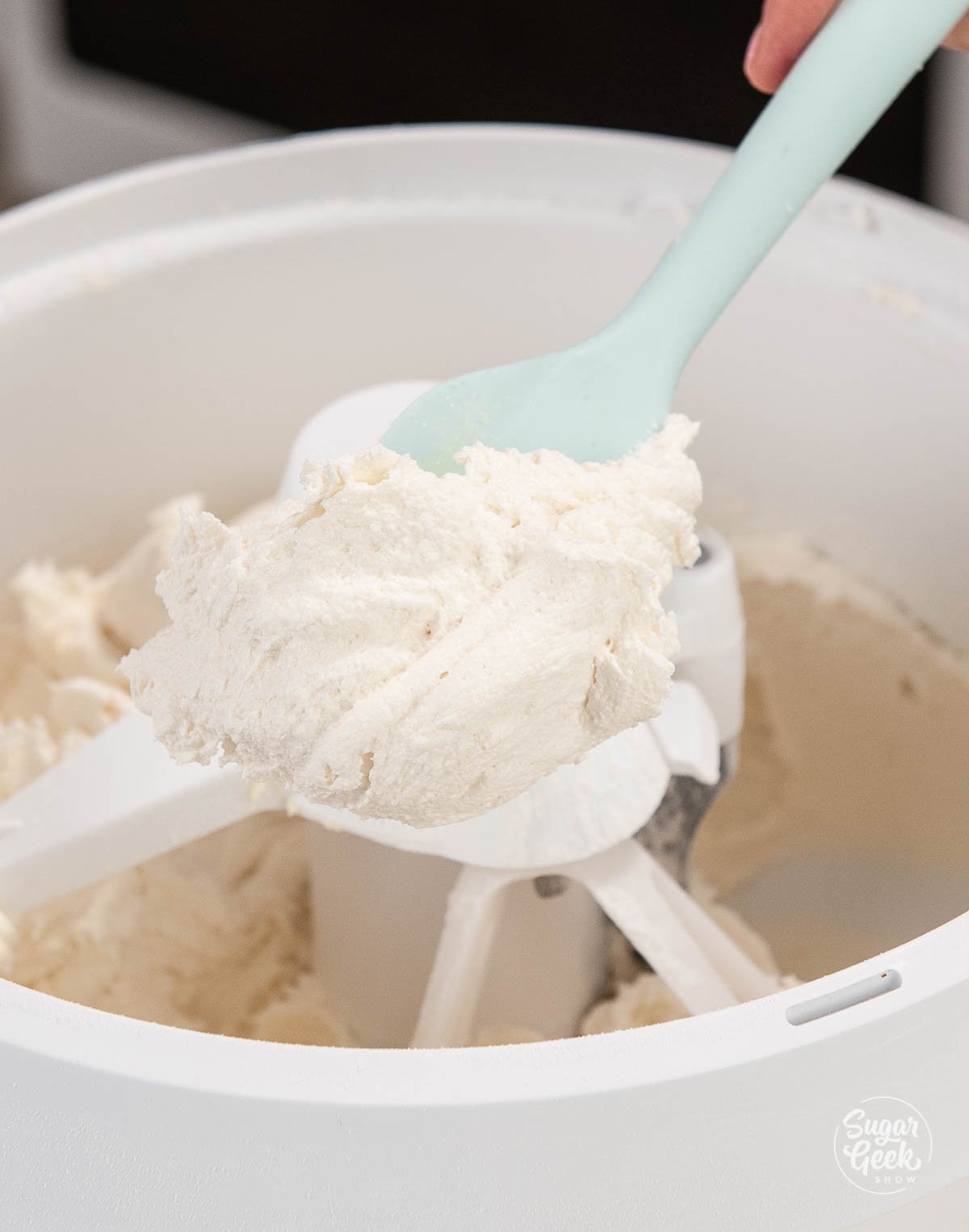
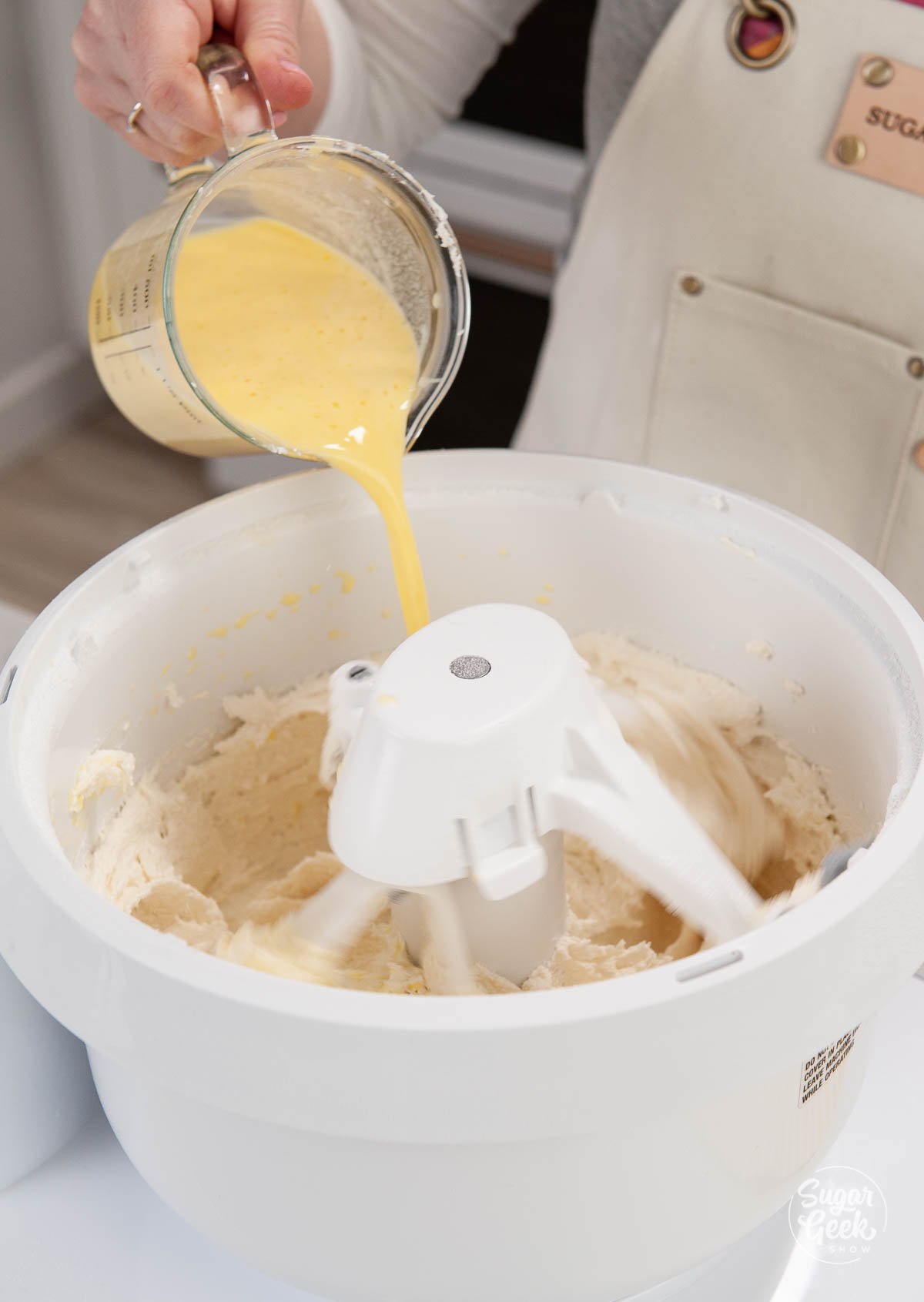
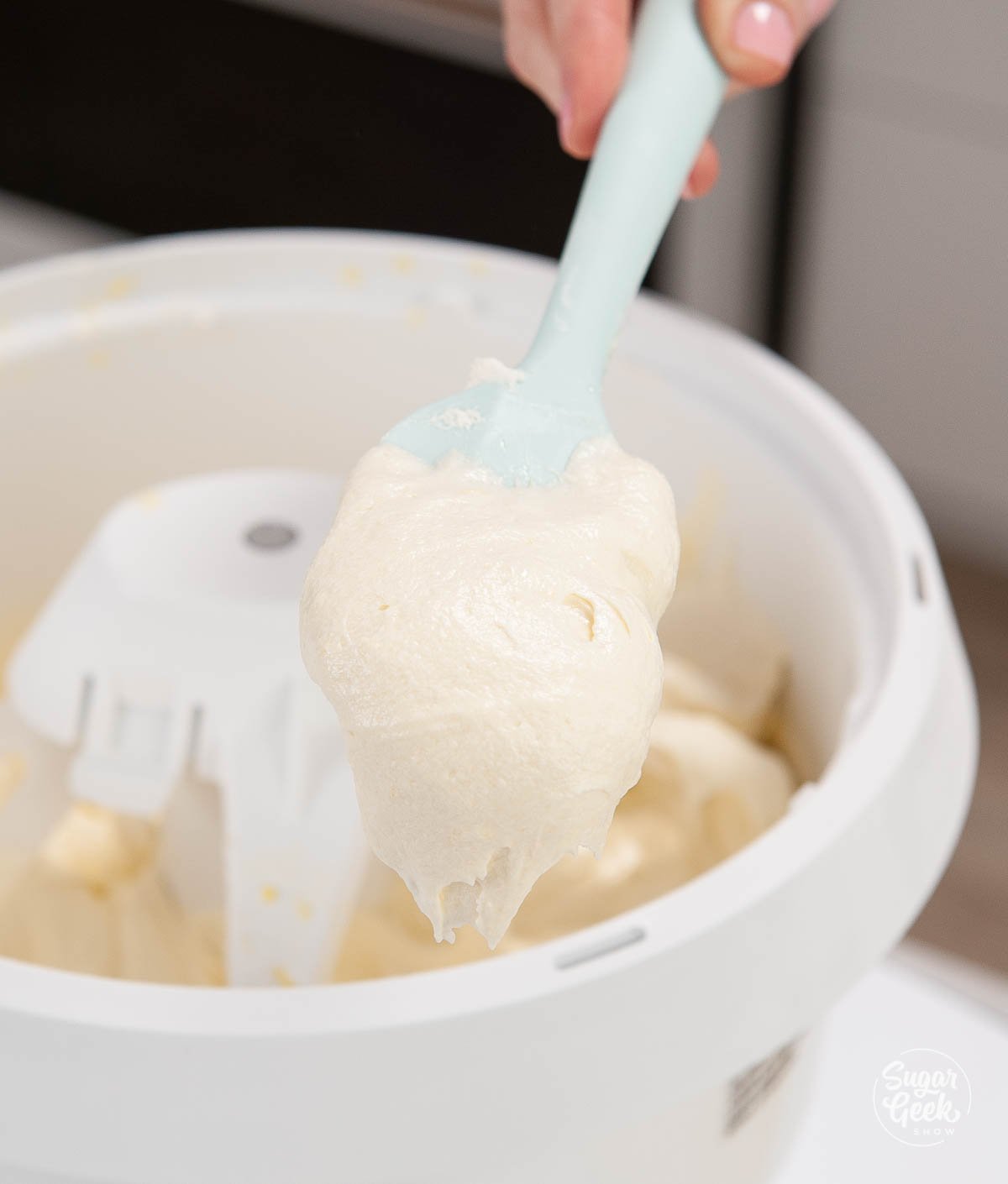
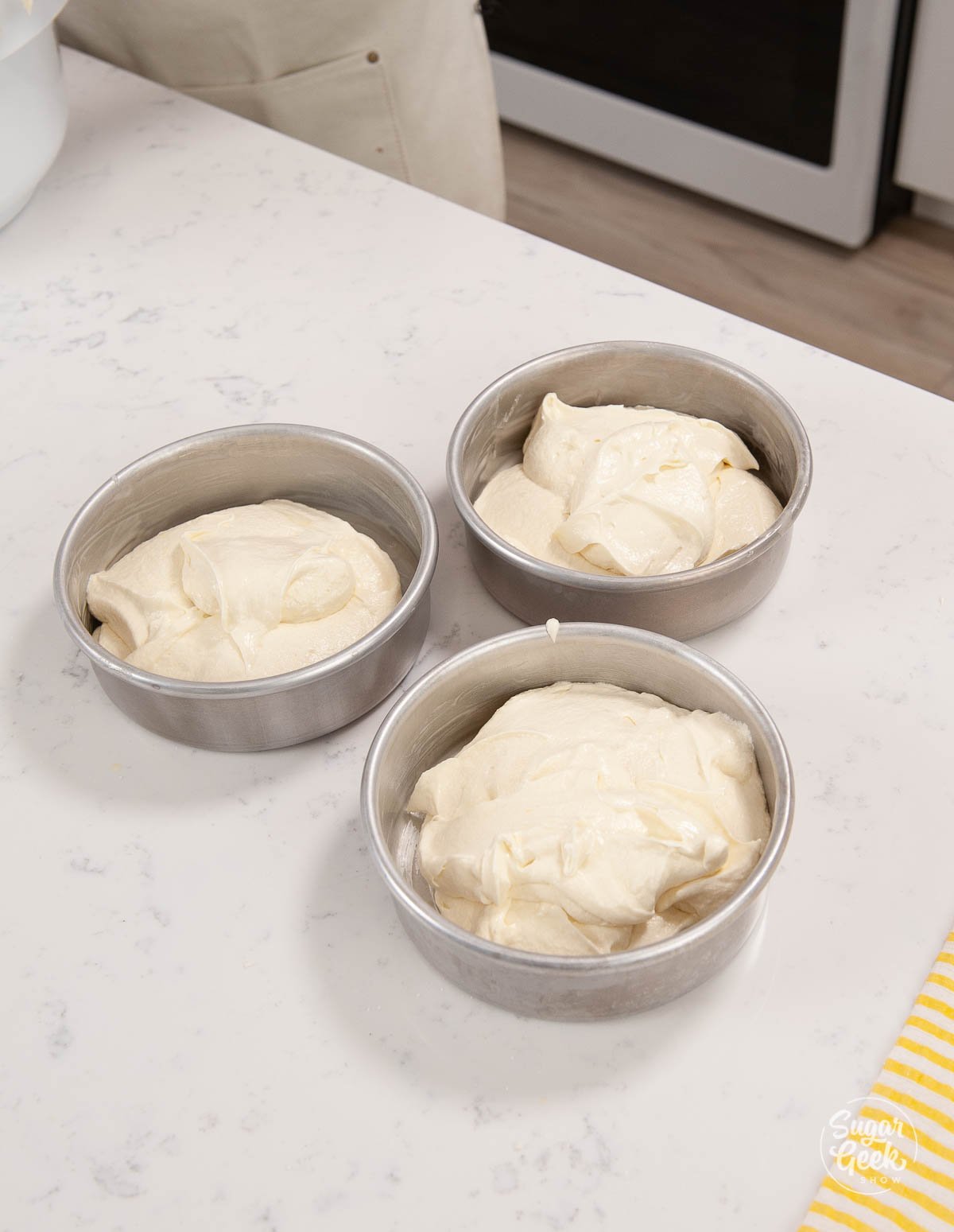
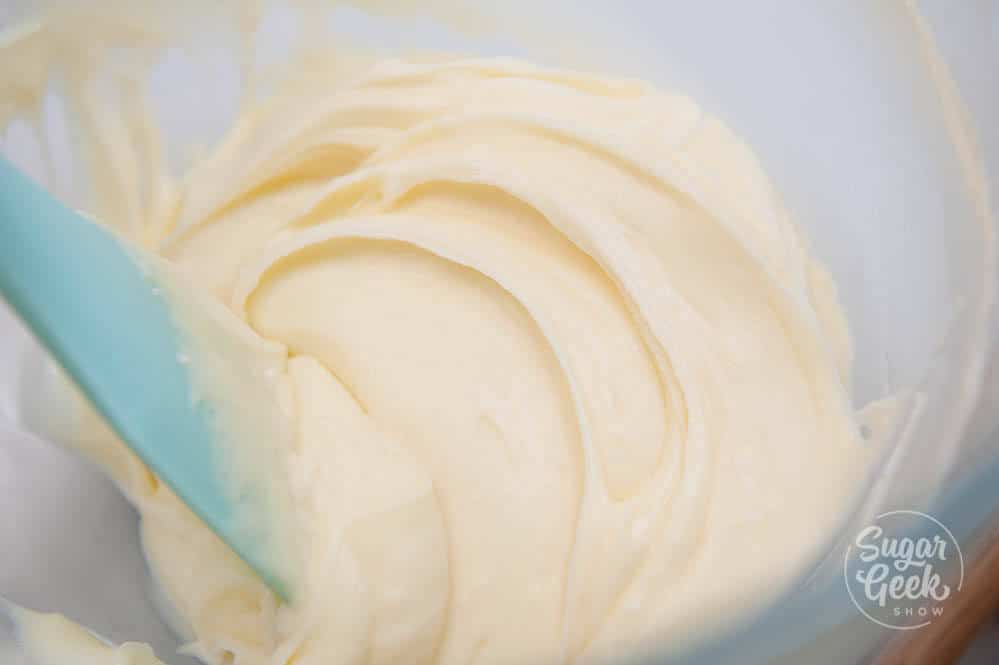
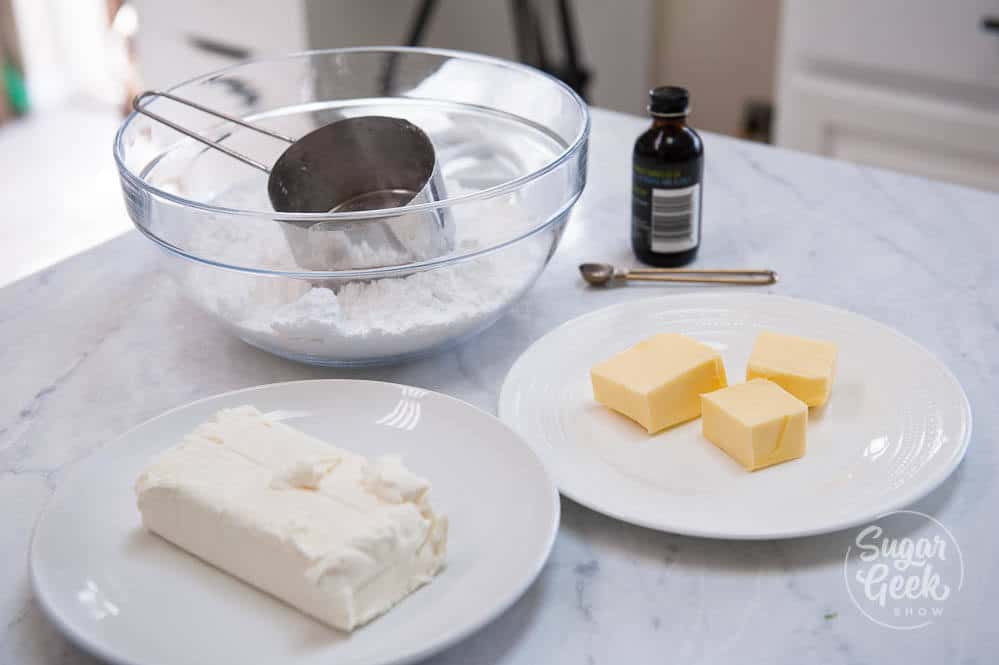

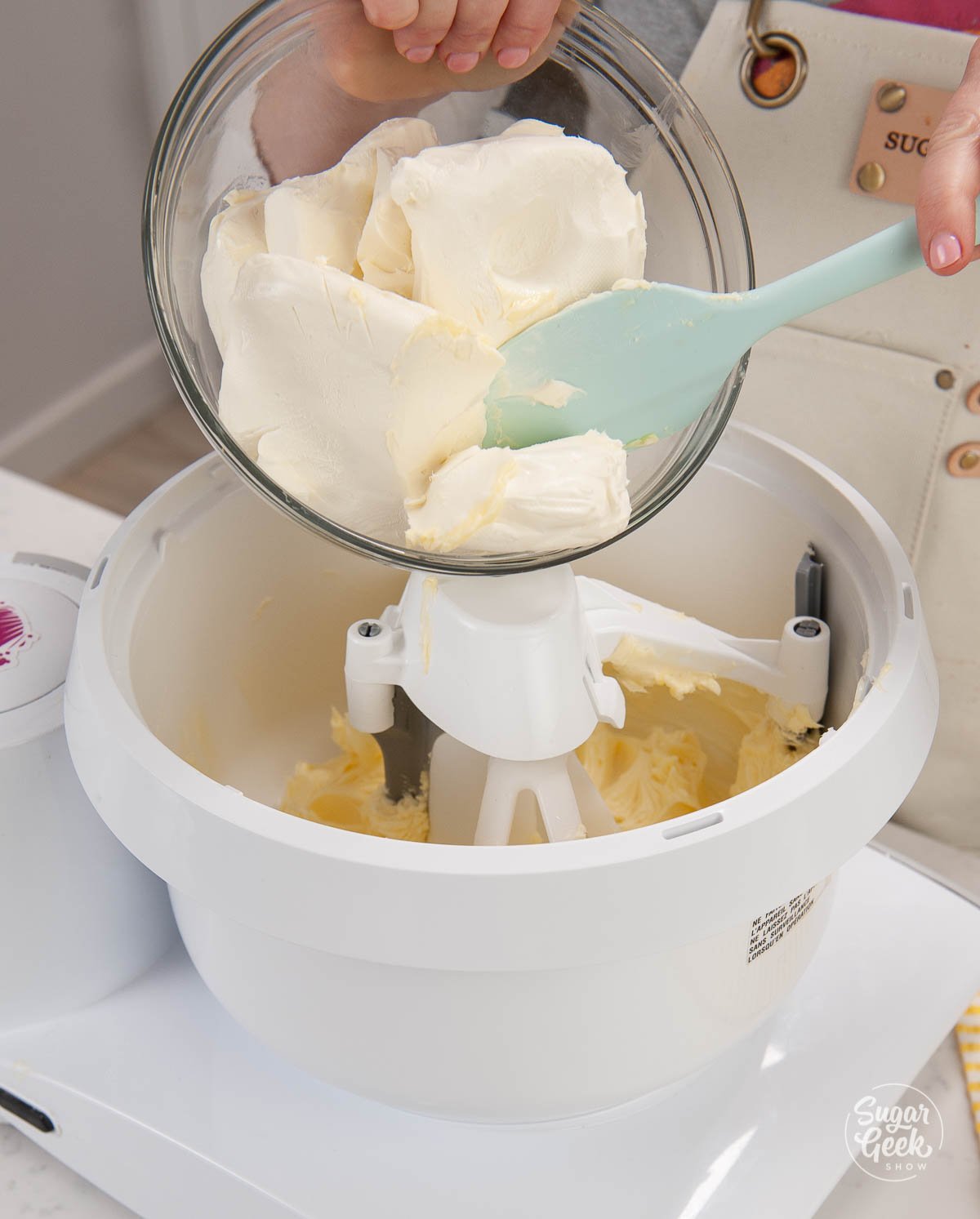
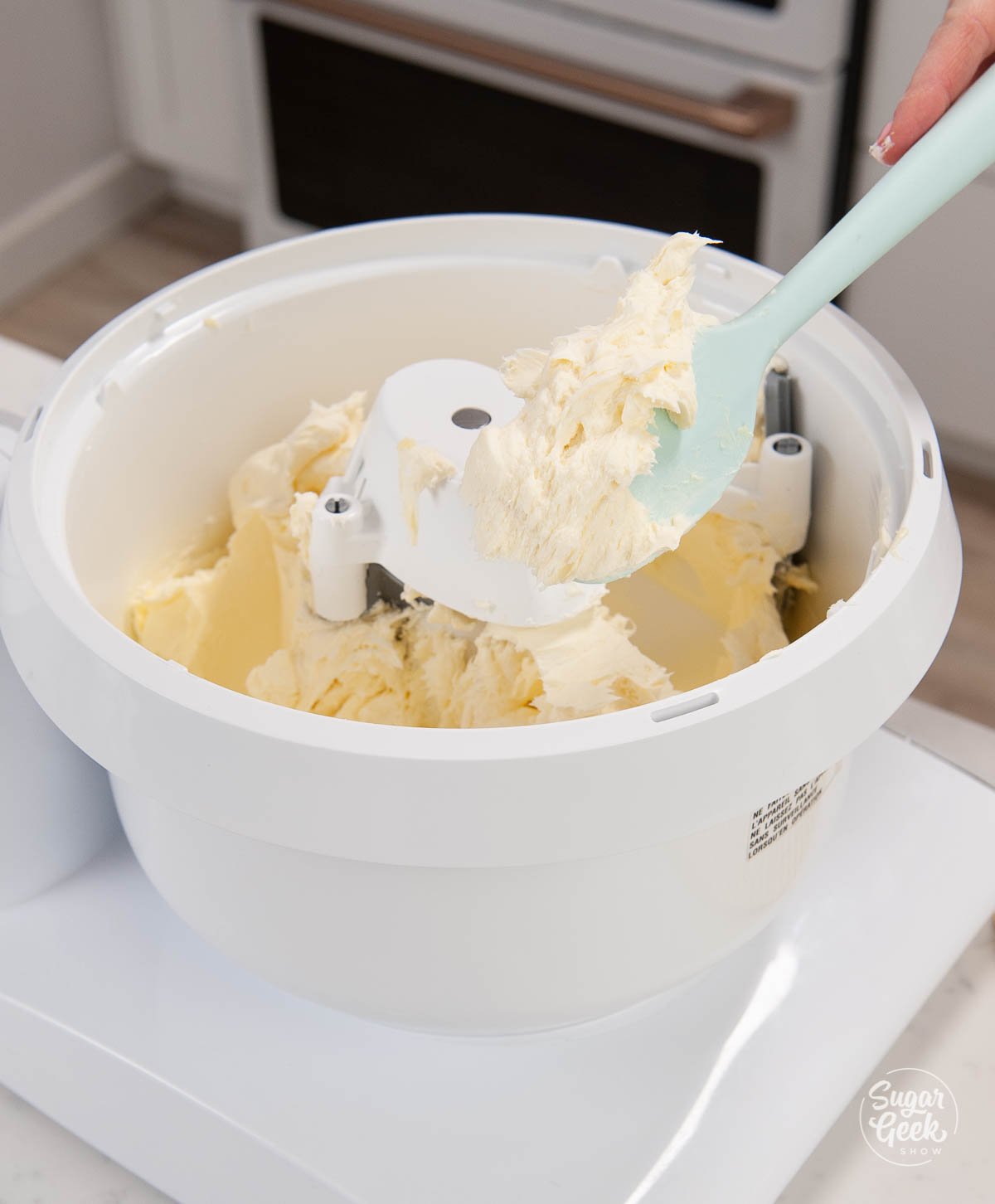
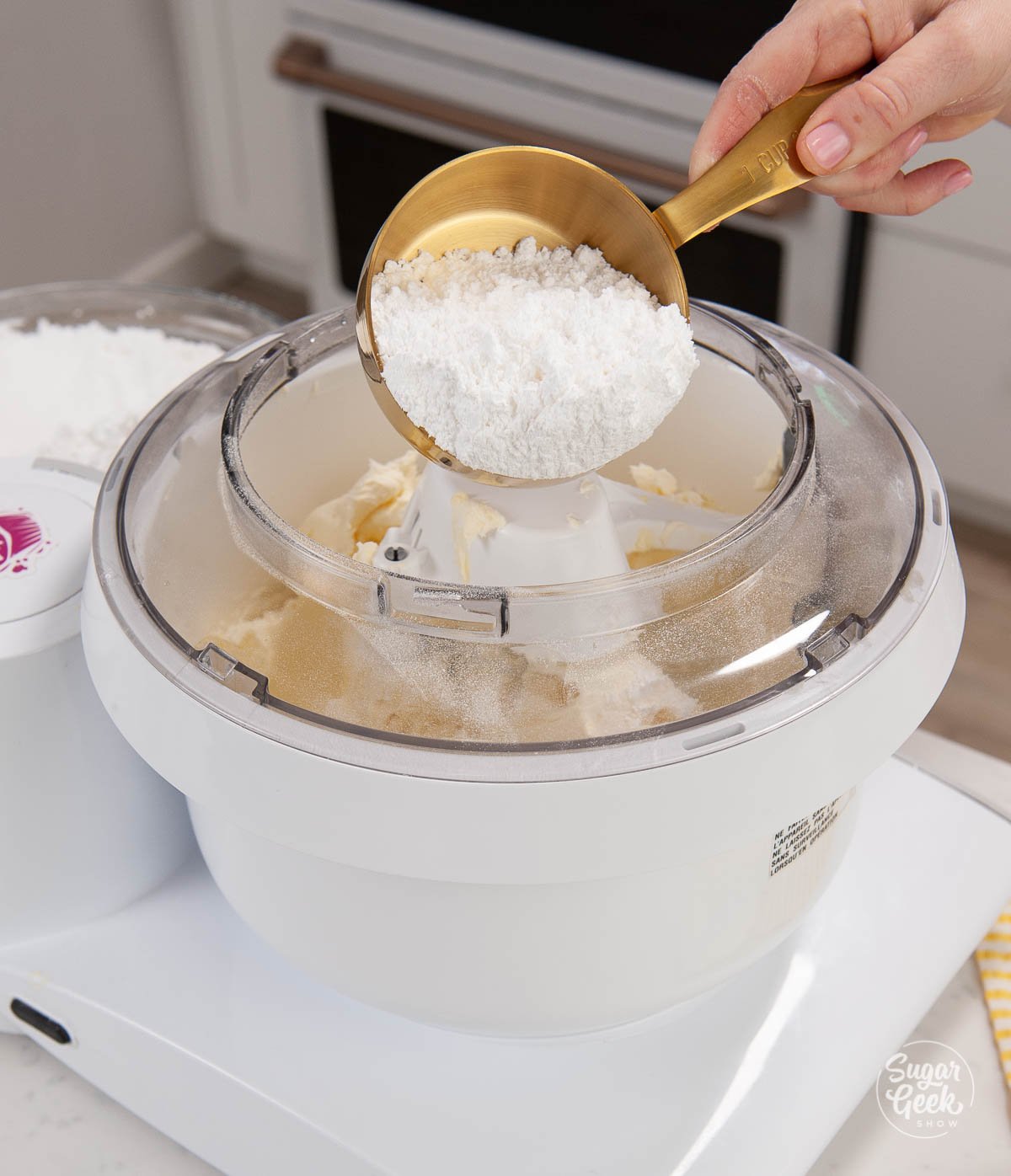
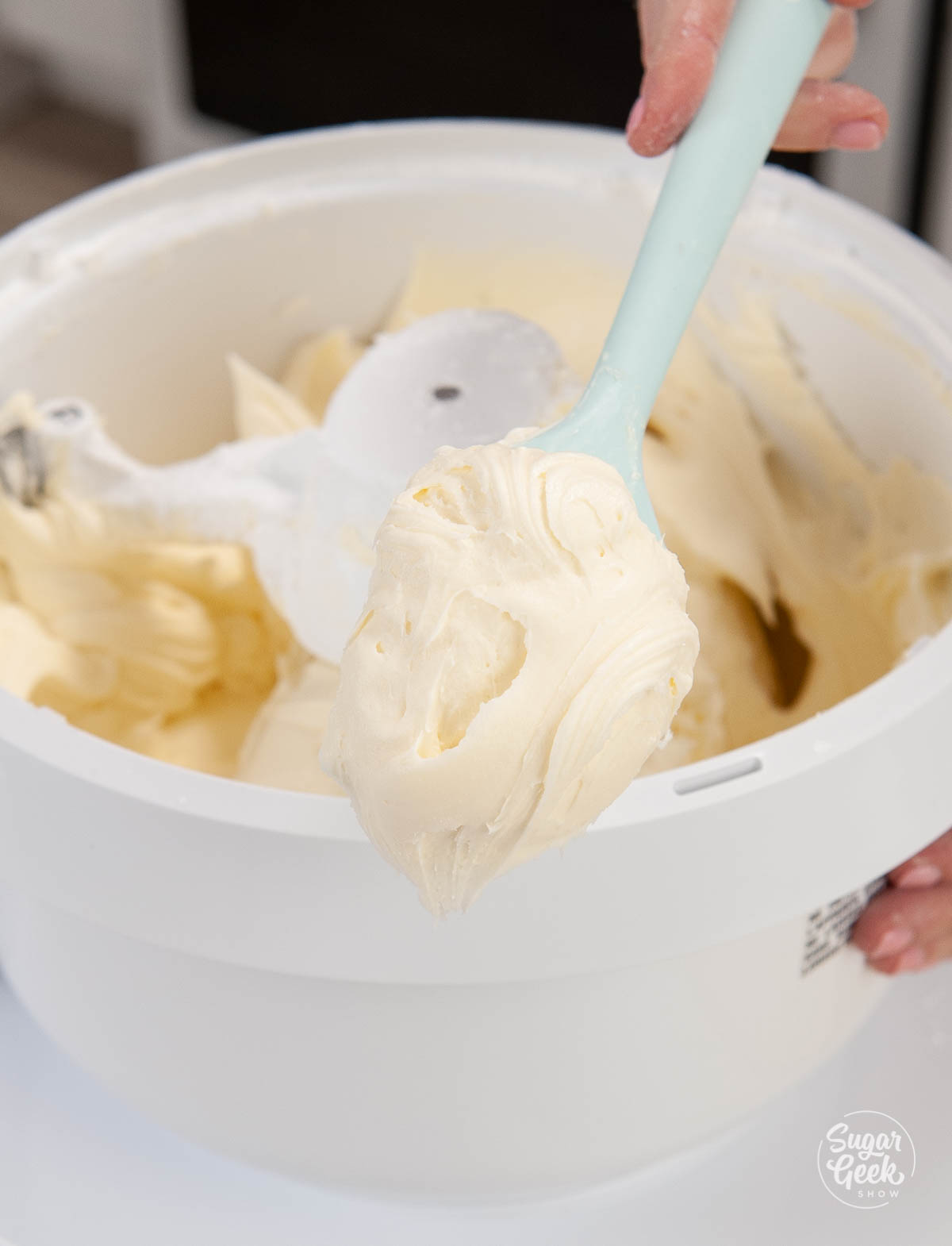
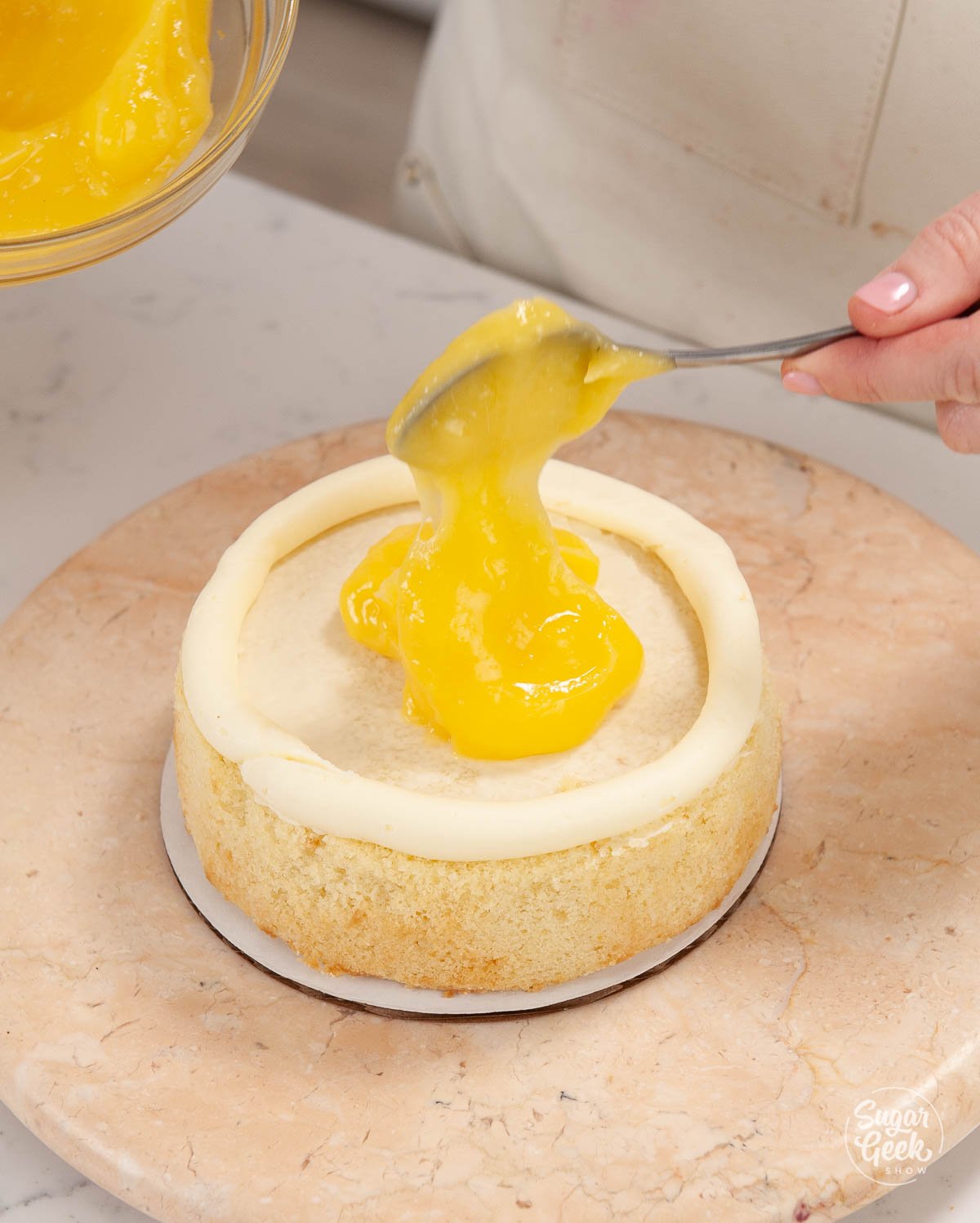
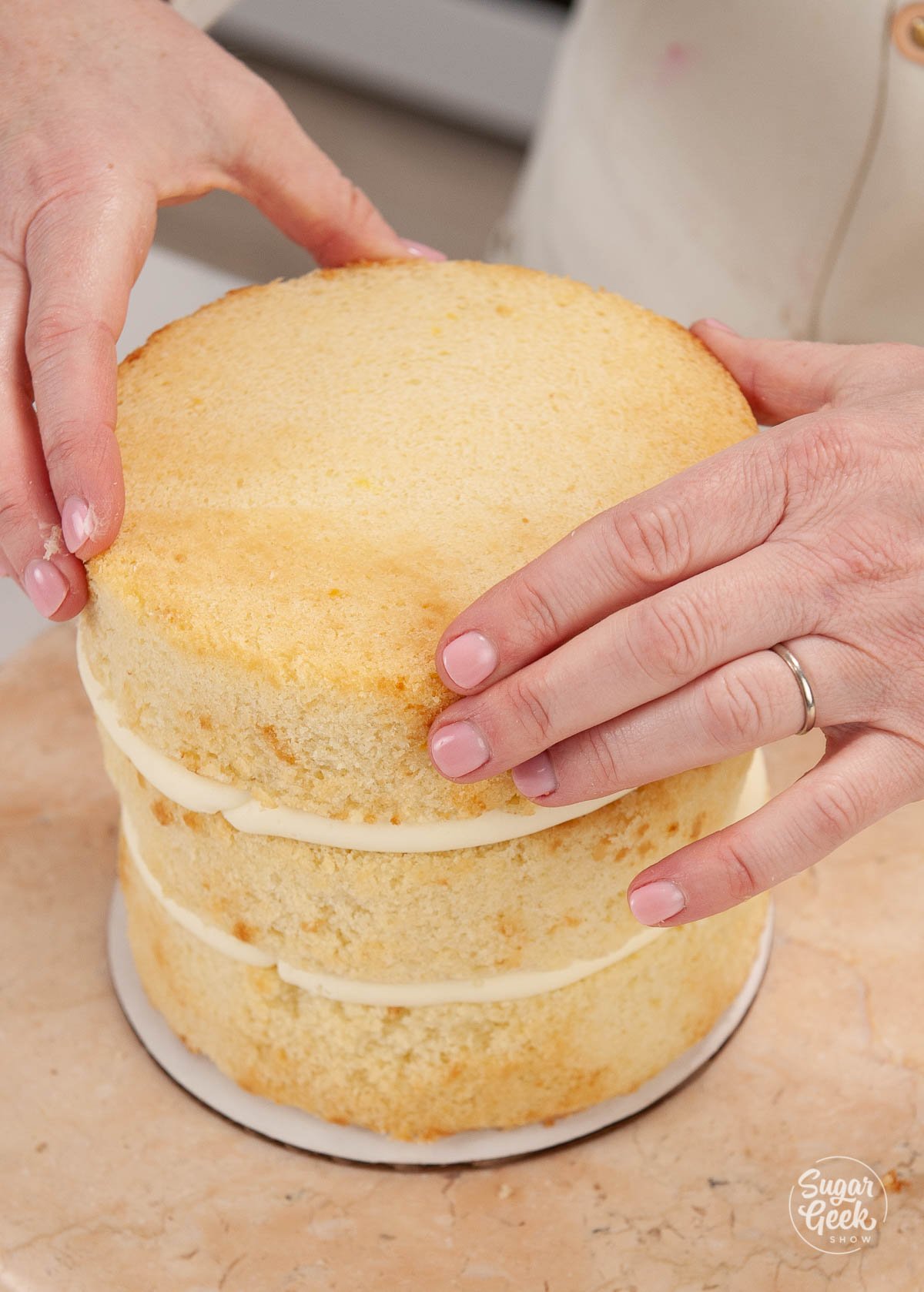
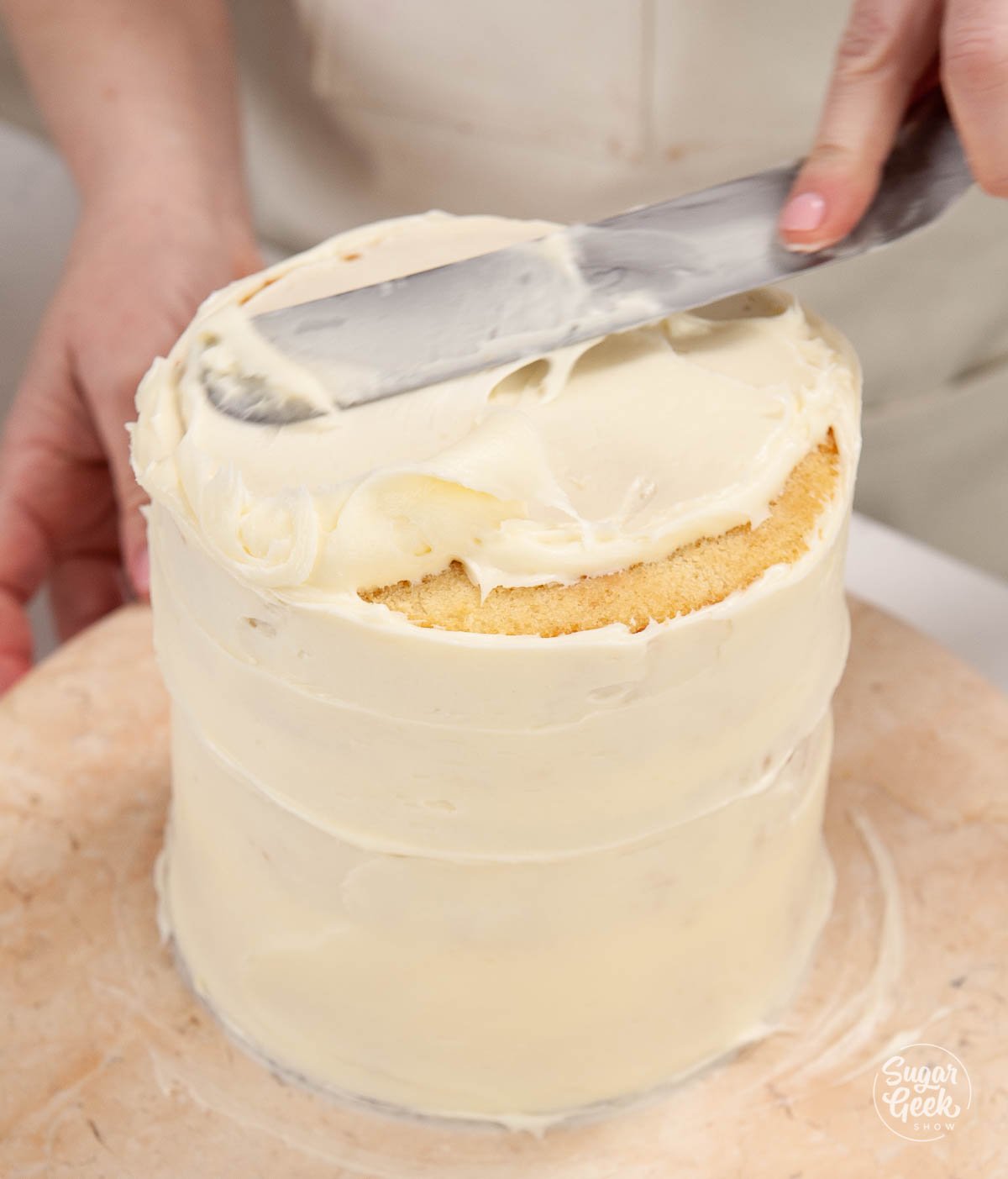
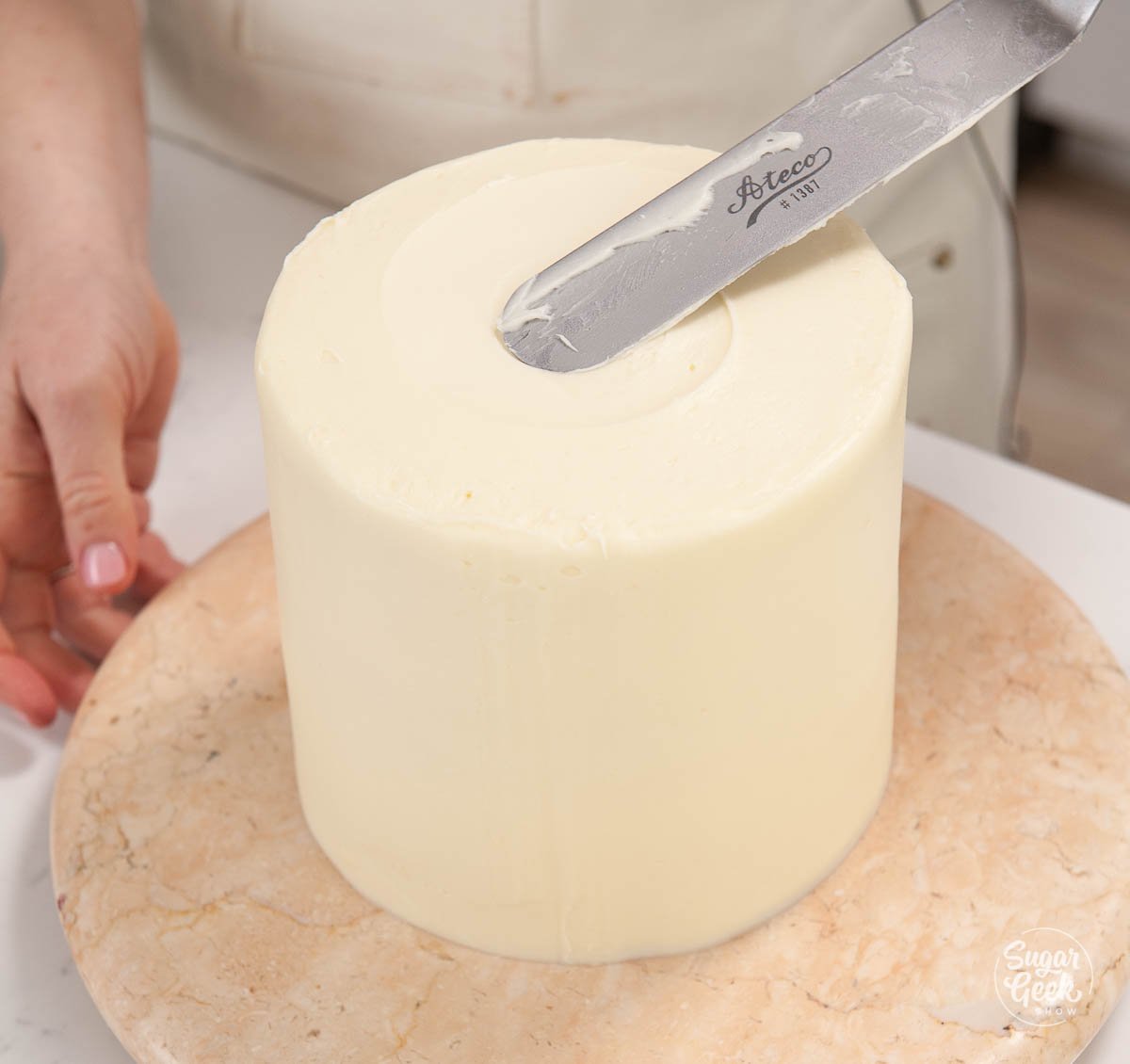
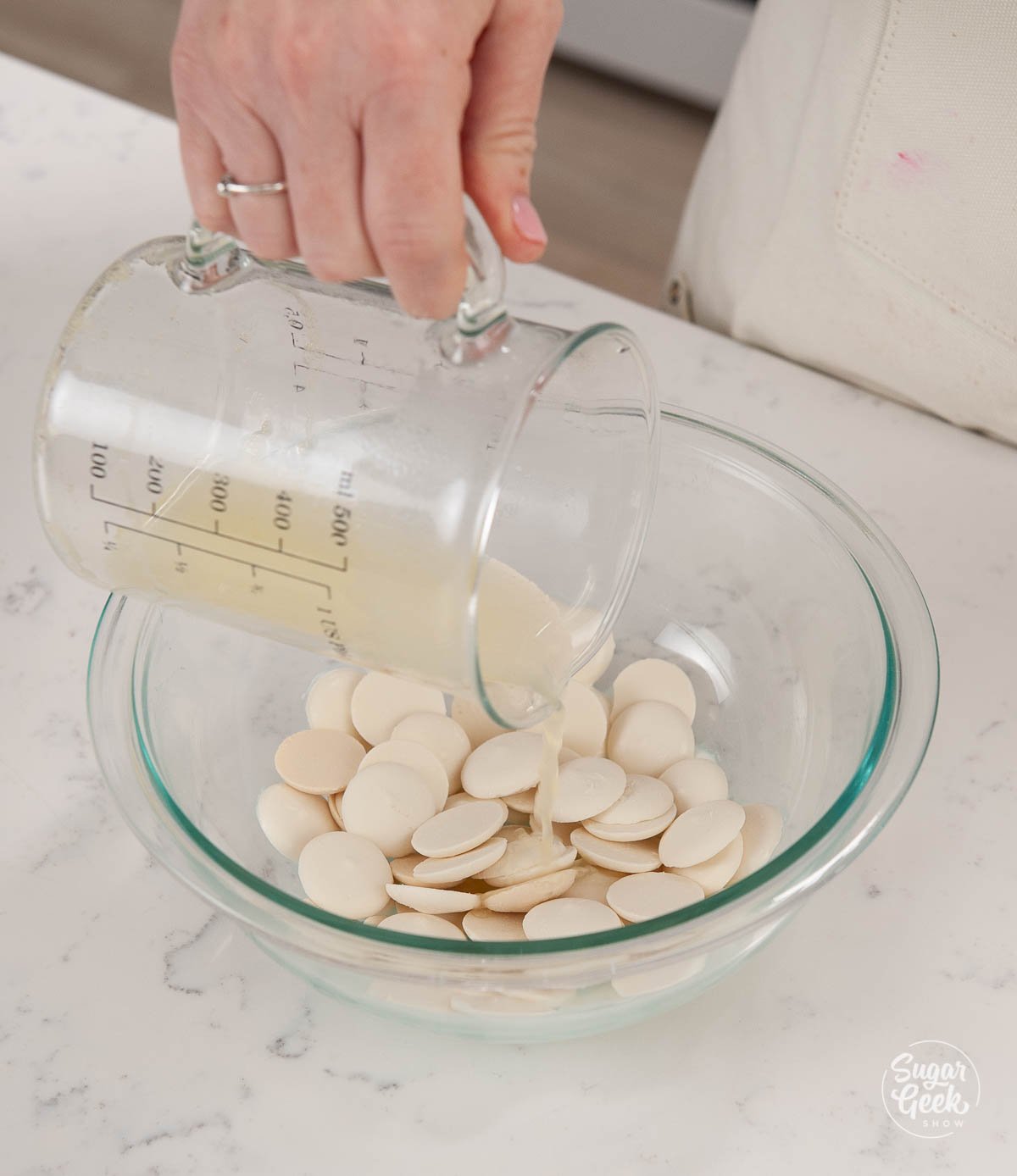
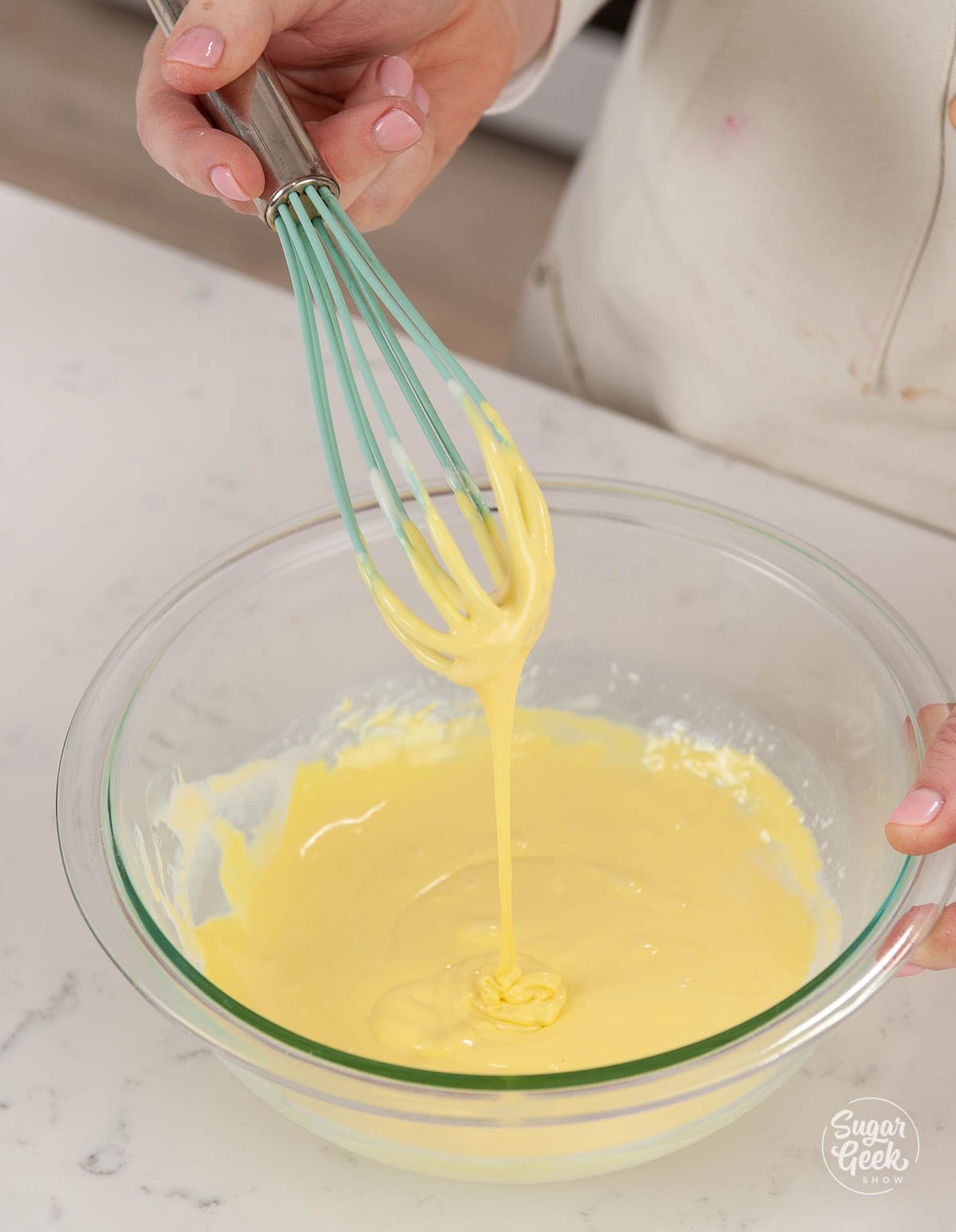
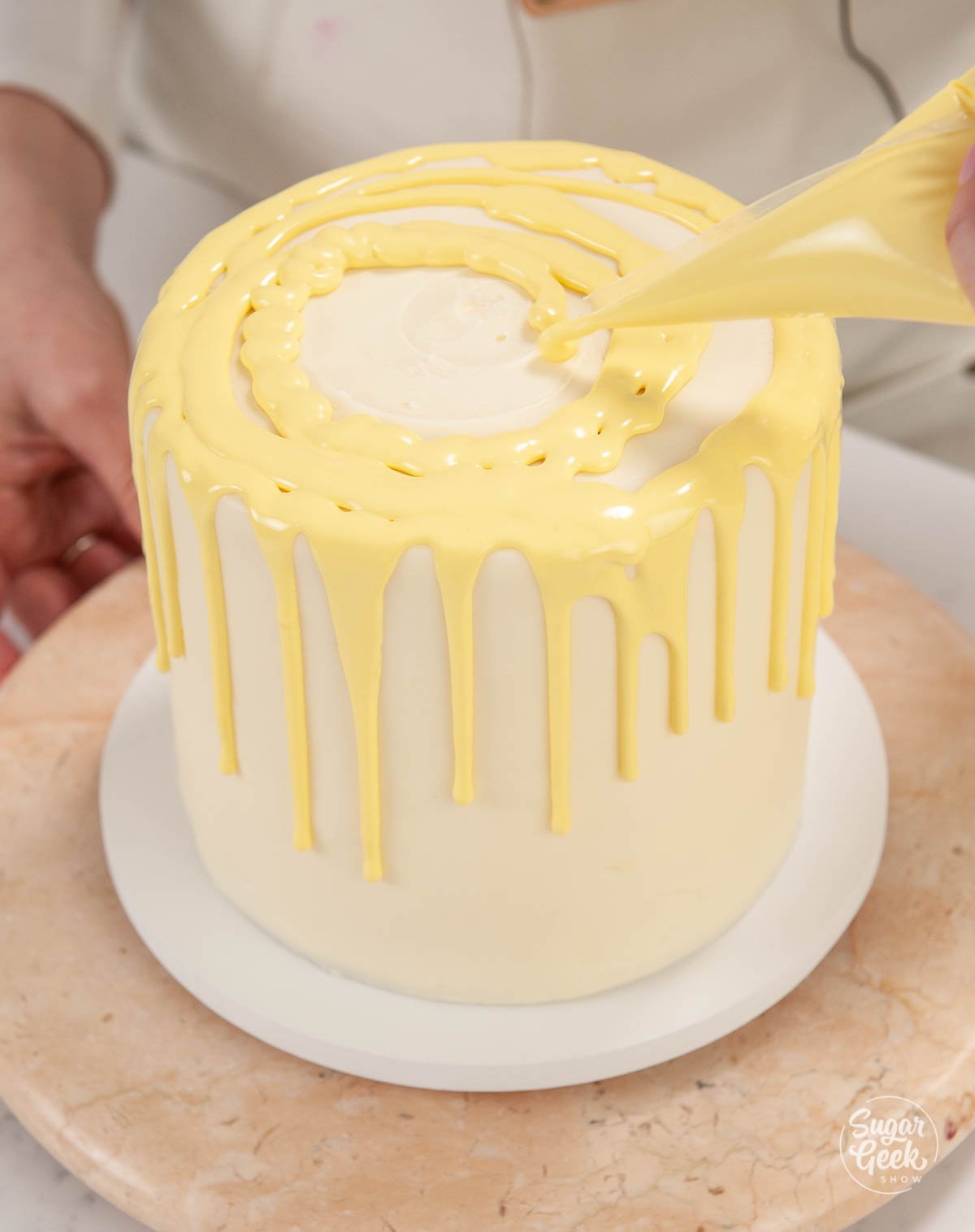
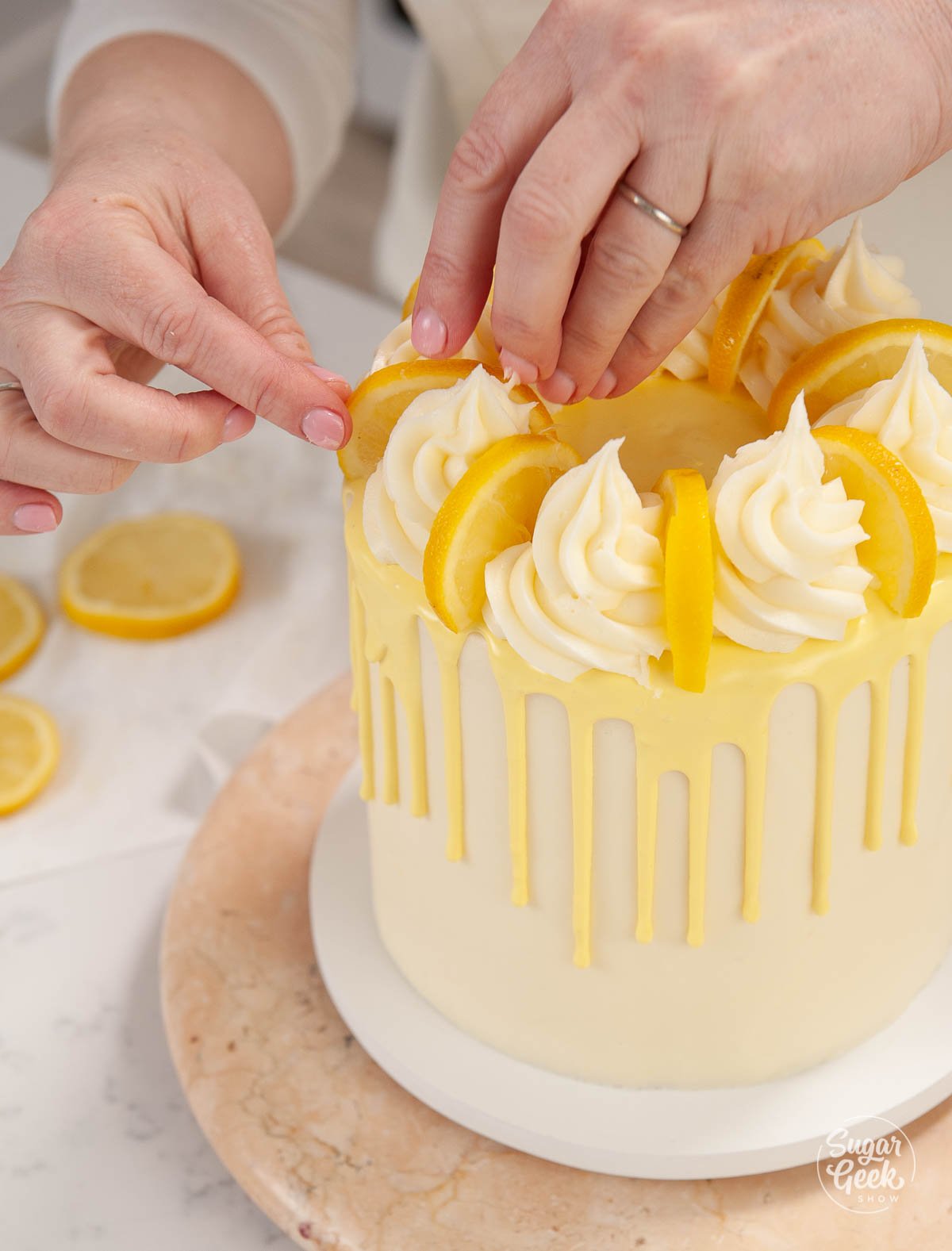

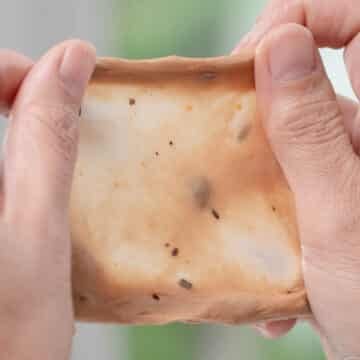

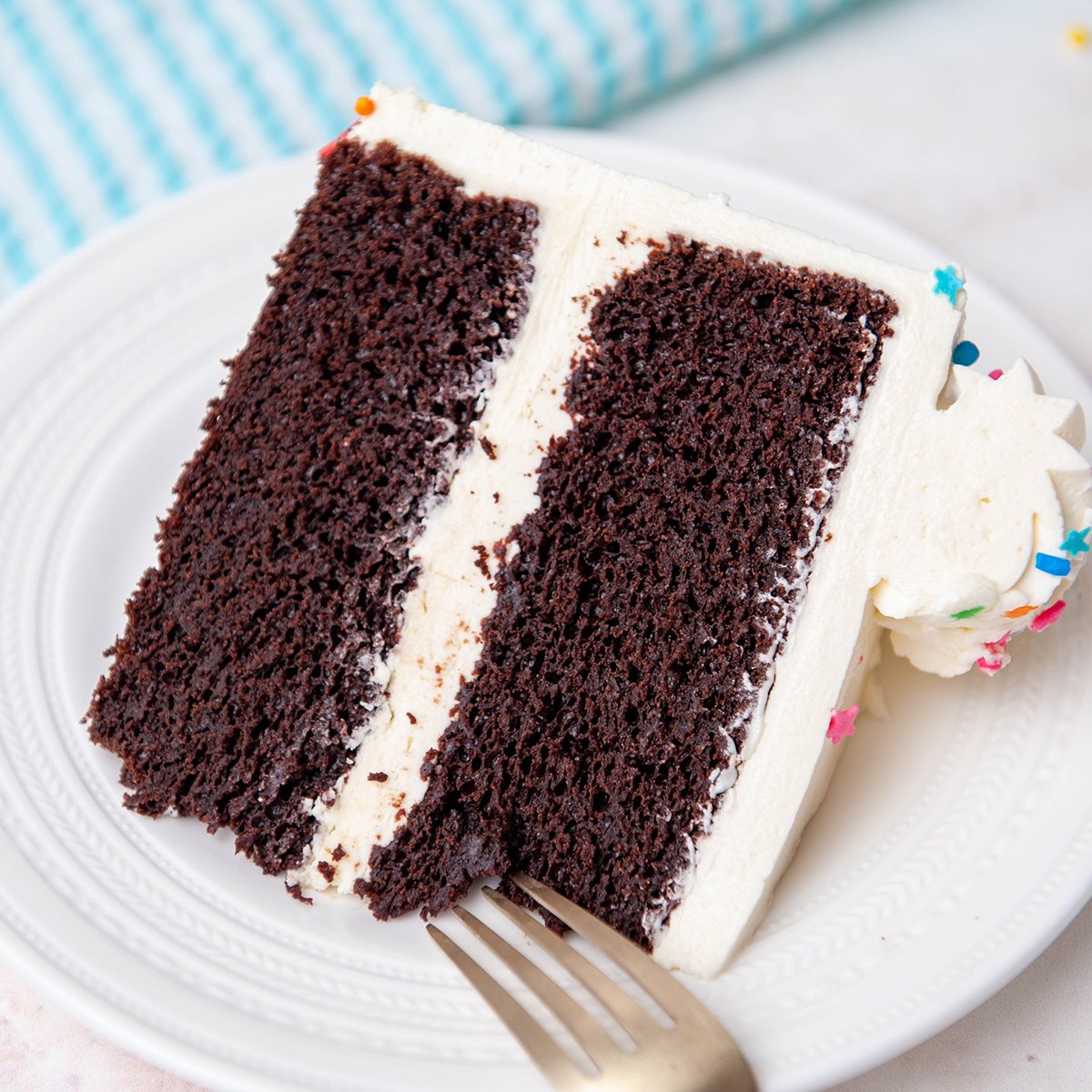
Kim says
Hi Liz i love this site. May I use this recipe for a 12x18x2 sheet cake, if so how do i make sure i have enough batter. Also may I use lemon juice insted of extract?
Elizabeth Marek says
Use the cake batter calculator right above the recipe card
Kimberly Marsh says
Hi. I really love this site. I would like to make this cake as a sheet cake (12x18x2). Is it possible with this recipe? If so how would I accomplish it?
Elizabeth Marek says
Use the cake pan calculator directly above the recipe card for other pan sizes.
Shawnie says
I made this tonight. Amazing! The texture is wonderful, nice flavor, nice rise. I will add a little more zest next time, but this is my go to lemon cake now! It is like your vanilla cake, which i love also. Thank you for sharing this recipe.
Uma G says
Hi can I freeze this cake for a week? After frosting, within how many days should it be consumed?
Elizabeth Marek says
Yes you can freeze it, I assume you mean the unfrosted layers and not a fully frosted cake. You should eat a cake as soon as possible after baking it because every day it dries out more and more. How many days exactly I dont know for sure.
Crystal Feimster says
So I was looking at your stand alone recipe for lemon curd and it varies a little from this lemon curd could you tell me the difference? I’ve already tried the curd in this recipe and it would not thicken
Elizabeth Marek says
Cooking for long enough and to a high enough temperature ensures the curd will thicken but if you can't get it to thicken enough, you can add cornstarch to the recipe to make it thicker.
Nana says
Hello, My daughter wants a lime cake for her birthday and was wondering if I just sub the lemon for lime?
I was also wondering what filling would go good with the lime cake besides lime curd?
Thank you so much for your recipes
Elizabeth Marek says
Yes you sure can, coconut is a great filling or even just vanilla whipped cream
Jessica says
Hi Liz,
Enjoying your site very much!!
Question about your pans for this recipe: Are they 6 x 3 or 6 x 2??
Thank you!
Elizabeth Marek says
They are 2" tall but you can use 3" pans if that is what you have
Grisel Borgos says
I just made this cake today for my daughter that loves anything and everything lemon. It turn out so pretty. I can’t wait to taste it tonight. I wish I can post a picture.
Rocio says
Hi,this lemon cake recipe can be cover with fondant? Thanks
Sugar Geek Show says
It is!
Jenny says
Hello, I have just tried your cake, sadly used fluid ounces instead of weighed ounces, will my bake be ruined?
Elizabeth Marek says
No it should still be ok
BOZENA IWUAMADI says
I have Lorraine Lemon emulsion. Can I use it in place of lemon extract? Will it be the same amount?
Elizabeth Marek says
Yes you can! It will work perfectly
Jane says
Hi Liz.
Any Idea if the brand Snowflake Cake flour will work for this recipe?
Thank you
Elizabeth Marek says
Any kind of cake flour will work 🙂
Carline says
Thank you for this recipe, been looking for a good from scratch lemon cake...... can I double the recipe with the same mesurement?
Sugar Geek Show says
Absolutely!
Carmen Hislop says
Hi my curd is really runny is there any way to fix this
Elizabeth Marek says
Make sure you cook the curd until it starts to bubble but not boil and then don't forget to add in the butter.
Ika says
Thank you for this great recipe, the cream cheese icing was super delicious and the custard was so good!
One question is…I changed the AP flour to Gluten Free Flour. But turn out the cake is a bit hard. Any suggestions if I’m using GF Flour?
Sugar Geek Show says
Hello, thank you, I'm glad that you liked the frosting and curd! Sorry that the cake didn't turn out right for you, I haven't tested this recipe with gluten-free flour and my cake recipes are formulated to work with specific types of flour. I do have one gluten-free recipe that I love if you haven't tried it yet! It works great with any frosting, too 🙂 https://sugargeekshow.com/recipe/gluten-free-cake/
Nikki Atkinson says
Aaaaaaah, please help, I was wanting to use this recipe for a wedding cake but I can’t get it right 🙈. I even made the investment in the more expensive Shipton Mill soft cake and pastry flour.
When cooked, the cake gives all the appearances of being done, risen, pulled away from the edges slightly, skewer comes out clean. However I’ve cut them in half to check them because of previous failures and their texture is very close and there is a definite line of very moist cake batter towards the bottom of the cake.
I have baked at a lower temp as the first batch was browning quickly.
I also find that British buttermilk is thicker than US.
My eggs are heavier than stated, 3 eggs is about tbl spoon more than stated.
Could I be over mixing it? I’m mixing a mid speed on a Kenwood Chef patisserie machine, what speed should I be mixing when adding in the egg mixture?
Elizabeth Marek says
sounds under-mixed and perhaps some ingredients are too cold which causes the batter to curdle and the fat to sink to the bottom. If anything mix more than you think you need to. US large eggs weigh 1.6 ounces so use that a your guide. Buttermilk should be ok. good luck!